Tower Hill State Park: making a difference












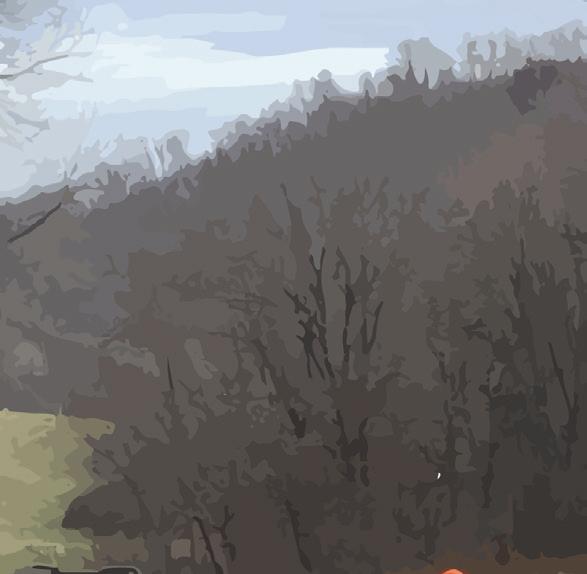





 Doug Swenson, Contributed
Doug Swenson, Contributed

The trail is open! Tower Hill State Park (5808 County Rd C, Spring Green) is a local River Valley treasure with stunning views, campsites and trails. But with a loss of state funding, a main trail on the north slope of the shot tower was closed for over 15 years due to physical deterioration and lack of budget to maintain it.
Paul and Jude Kuenn, residents of Appleton, have been coming to the park over the years to camp, hike and enjoy the proximity to APT, the river and the community. Seeing a need that was not being filled, they jumped into action and spearheaded the trail repair with some local volunteers. Over two years of repairs and 464 volunteer hours later, the trail is once again open for hikers. The “trail closed” sign that has kept hikers off the trail for 15+ years was removed on October 30 and the trail will be available for all when the park reopens next May.
Paul Kuenn is a consultant for deep energy retrofits and solar installations in homes and businesses, and along with these skills, he is a true handyman. He and Jude are outdoor enthusiasts and passionate about the arts and nature. This trail repair is not the only Tower Hill project they have volunteered to fix. In 2017 they rebuilt a historical stone bread oven and in 2018 rebuilt and reorganized the shot tower exhibit after
it had been vandalized and fallen into disrepair. Working with park ranger Pat Kraska and local resident Ellis (Skip) Pifer, who lived on the property in his childhood, Paul and Jude updated the exhibit with electrical wiring, lighting and wood framing, restored photos and paintings, and replaced a mining pickaxe from the period that had been stolen from the display.
With these updates completed, Paul
and Jude took on the much larger task of rebuilding the trail in October of 2020. Securing the mid-level trail winding down the north slope of the shot tower that had eroded and crumbled into a stone pile was no easy task. Rebar was pounded into the lower side of the trail where a new dry stacked stone wall was built; cracked and crumbled stone stairs were removed, and gravel brought in bucket by bucket as new stairs were replaced; and the upper stone

Arena Historians to hold Harvest Celebration with storyteller Cecilia Farran
The Arena Historians will host a harvest table of home made and locally grown food November 21 at 6:30 p.m. at Grandma Mary’s Brisbane Hall (175 Hwy 14, Arena). Folks are invited to bring samples of their homemade bread along with locally sourced family favorite foods that pair well with bread such as jams, jellies or other preserves perhaps
from recipes passed down through the generations or even local honey.
Also suggested are home made or local cheeses, sausages, hand churned butter, juices or wine or home brewed beer or even pies and sweets made with locally grown or foraged produce, all to be sampled in a smorgasbord of the fruits of the land.

Before the sampling, local storyteller Cecilia Farran will set the tone as she shares “Daily Bread,” a true story that takes place at the noon dinner table in her family farmhouse kitchen. It is a harvest tale of the wisdom of those who live on the land and take sustenance from it, even in times of hardship. Drawn from her memories of farm
retaining wall was rebuilt. Dry stacking the stones, using both original sandstone and limestone from a nearby quarry, created a strong wall using gravity, not cement, to secure the wall and keep the soil from eroding. Large limestone rocks were brought to the top of the trail, then hauled to the site with a 2-person rock carrier that Paul built, emulating the same method the Civilian Conservation Corps used when they built the original terraced trail in the ‘30s and ‘40s. The dense stepping stones can weigh up to 200 pounds, so the carrier was a perfect solution for getting the stones into place.
Tower Hill State Park still has many maintenance projects in its future, but the generosity and passion of Paul and Jude Kuenn will always be evident in the stone walls and path they have rebuilt, a true community gift that will not fade away with time. Some of the volunteers that Paul and Jude have motivated during their time at the park include Ellis Pifer, Kim Nolet, Bob Johnson, Mark Berres, Max Berres, Patipat (Petch) Tuongheeranchort, Jan and Dean Swenson, Doug Swenson, Omar Lopez, Chuck and Denise ValentiHein, Patti Zarling, Timm Zumm and Earl Straiter.

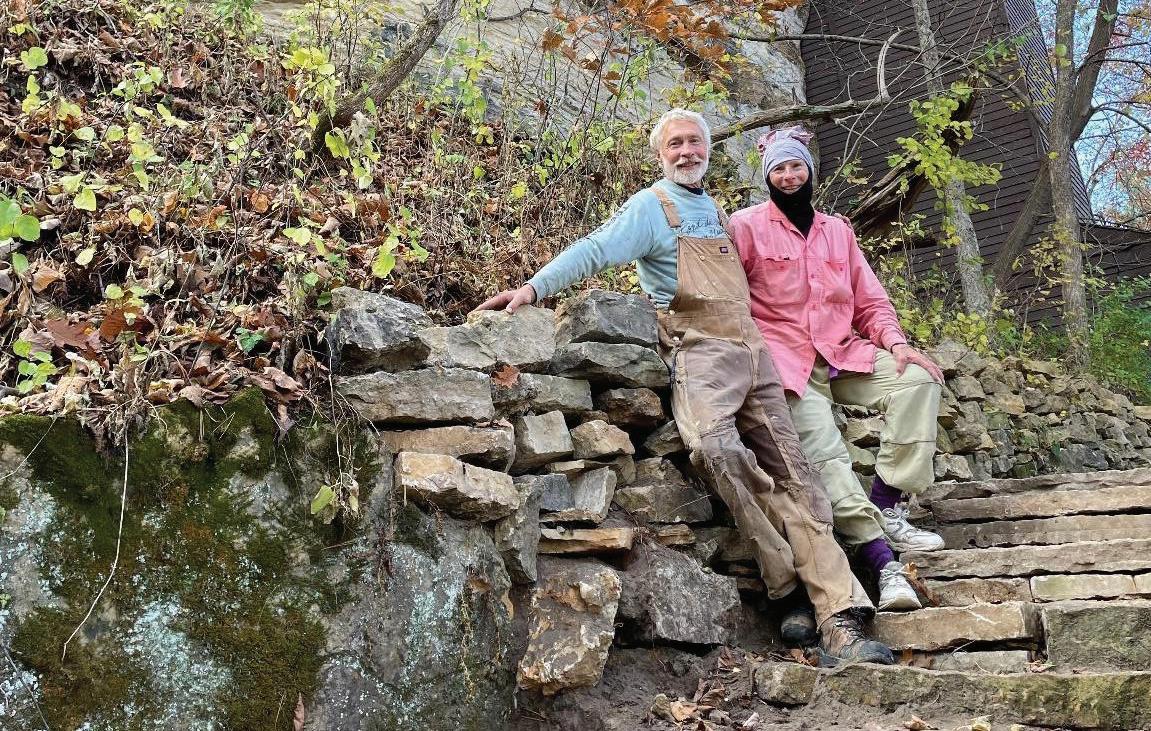
With park budget cuts and no active Civilian Conservation Corp today, this type of volunteerism and visioning is perhaps the new way forward.
life Cecilia creates a rich tapestry of feelings, earthy character and agrarian wisdom, interwoven with the circle of the seasons and the sacredness of place. It is a touching tale of her father and the wheat he raised, and of her mother, who ground that wheat into flour and made
Thursday, November 17, 2022 | Vol. 3, No. 26 Spring Green, Wisconsin FREE , Single-Copy
Profile: Katie Green on Bob McQuade
Inside this edition Page 2 Pages 6, 7 Pages
12
Community Calendar: Workshops, Open Mic, Live Music Deer Hunting: Columns and Forecast
2, 4, 11,
continued on page 9
Photo contributed by Doug Swenson Paul and Jude Kuenn live in Appleton and are members of various Wisconsin state park non-profit 'Friends' organizations, including The Friends of Devil's Lake, Rock Island, Point Beach, and Potowatomi. They'd like to see a similar group created for Tower Hill State Park.
The (not so) Plain and Simple Correspondent: A Good Life — Bob McQuade

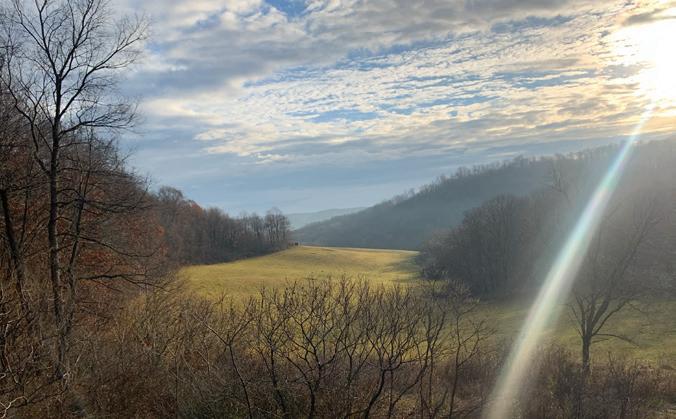 Katie Green, Columnist
Katie Green, Columnist
Bob McQuade claims to have retired four times. Beats me how to tell retirement from non-retirement when the man is apparently continuing to do what he has always done at almost breakneck speed. At a recent pop-up art exhibit for Jean-Marc Richel, noted artist and chef who lived in the Mineral Point and then Spring Green communities until recently, Bob and his life partner Kate produced plates of bitesized savories and sweets for visitors to munch on besides readying special orders of the breads for which they are famous. Exfoliating clouds of flour, aproned Kate wafted in and out of the exhibit area from the kitchen while Bob, who just celebrated his 91st birthday and had cooked earlier in morning, mostly sat and schmoozed with the locals and exchanged pleasantries with strangers who happened in. It was a beauteous autumn day and tourism was humming inside and out along the highway.
We first met Bob and Kate at a Cinco de Mayo celebration in Lone Rock, to which we were carried by thoughtful neighbors when we first moved to rural Spring Green in 2005. The McQuades supplied many goodies for that event and there I learned about their enterprise along Highway 14 in Arena, called The Shoppe: Herbs, Spices and More. So much more! Their cozy little shop with the signature red roof and handmade wooden door is an important community gathering spot. Over time we have bought enough olive oil there to float a battleship, besides bags of spices and baked goods, not to mention chomping pizza on Tuesday nights in summer, when pizzas are made to order, baked in a wood fired brick oven built by friends and family out back of the shop. Musicians warble and twang away to help one pass the time agreeably while one waits at little tables to be served. For a long time a group of the faithful met on Sunday mornings, calling themselves The Church of the Cinnamon Role, but no more. I'm sure the aroma in the shop was divine, but we sought divinity elsewhere closer to our home in a building with a preacher and the conventional spiritual trimmings.
As our friendship blossomed, I discovered that Bob and I share a birthday, so I facetiously call him my Evil Twin and each October 3 am sure to place a phone call to encourage him to remain upright another year. With
On the cover
ancestry from Ireland and Sicily, who knows but that at any time he might explode in fiery fragments or evaporate in a puff of smoke? He has a volcanic mixture of bloodlines. He is an eminently decent man, anything but evil, as it happens, but he has a healthy ego, quite satisfied with his considered opinion in any exchange of views. In fact, when Kate first met him in New York City, she didn't like him. She was a dancer between gigs and to tide herself over applied to be a cashier at the Harvest House Restaurant (kind of like a Perkins, he told me) where Bob was a manager. He turned thumbs down on hiring her because of her lack of experience, but his boss over-rode that decision. Her competence was soon demonstrated amply, whereupon Bob reassessed his first impression and asked for a date. Kate spurned the request, still irked at his lack of trust in her abilities. He persisted. She rejected. He persisted. She weakened. I have seen a photo of Bob at that young age and he was a very handsome fellow. He still is, but the curly raven locks have turned to silver.
Bob also teaches cooking classes at the Shoppe. I signed up for one years ago, desirous of acquiring the skill to make crème caramel, a personal favorite of mine and one of the dishes on the menu we were offered. He is still conducting classes, passing on his knowledge, limited to a handful of eager beavers at a time in the intimate kitchen. Much nicer than watching a televised cooking demonstration, since the ultimate dividend is that the students get to eat the results! The dinners he used to prepare periodically at The Shed in Spring Green halted (lamentably) when that loved establishment closed (in part), but he still does the occasional dinner at the Post House Garden or prepares a soup or pasta night at the Shoppe.
The McQuades are parents of five children. Their son Michael, a carpenter, did some of the transformation of the little building, which was previously the Country Cottage Gift Shop, into a home, bakery and shop. (Mike also worked on projects for our house in rural Spring Green.) They have been living in this


home, running this business, for 37 years, the longest they have lingered anywhere as they roamed the planet. Both are originally from the Bergen Co. New Jersey/Philadelphia environs, and when Kate wanted out of the polluted atmosphere of greater New York, they embarked on “a strange progression” — went for a while to NJ, “couldn't afford CT”, then headed West to Hibbing, MN, where Kate had gone on tour once with her dance troop, remembering it as verdant, pure-aired and beautiful. You know, Hibbing, home to Robert Zimmerman, alias Bob Dylan? They bought a farm outside town, former city girl Kate embraced country living, complete to being a milkmaid in earnest, not as just a distraction from boredom like the French queen Marie Antoinette. Besides learning to milk their cow, she also opened a dance studio, while Bob operated a new restaurant in Hibbing. After 13 years of freezing there on the outskirts of the North Pole, they came south to our banana belt. Of Hibbing, Bob says, “People were very nice, but you were lucky to have summer one Sunday when you could have a picnic.” Next stop was Boscobel for a time. While living there, their youngest son was State wrestling champion – and twenty years later that son's sons were also wrestling champs. Now that son is and has been principal of Appleton West High School for many years.

Bob and Kate are proud of their children, “who are all doing all right”, and never had anything handed to them on a platter. No weekly allowances or anything cushy like that. They, as he did, have had to make their own way. His father, whose family was from Co. Cork, was the first generation to be born in the US. Same with his Italian mother. For a long time after taking a Sicilian woman as his bride, his father didn't like Italian food, especially hated spaghetti, so the only time Bob's Sicilian mother and grandmother got to prepare their traditional specialties was on Wednesdays, dubbed “Italian Day”, when his father went off to visit his Irish mother. Both his maternal parent and grandparent were “fabulous cooks”,
says Bob, and he owes much to them.
By scrimping and saving the McQuades have been able to travel to Ireland, England, and the Continent a few times. They were in Ireland on 9/11 and were told by a Northern Irishman, “Don't let the bastards grind you down.We Irish have always fought each other and know how to survive.” By additional scrimping they also traveled to Sicily at least five times. “People assume, since we have our own business, that we're rich,” Bob says with a snicker. They have had to work long, relentless hours for what they have and are grateful, but “rich” is hardly the apt term to describe them or most small businessmen and women. Kate does the financial books for the enterprises, complaining that the paperwork “breeds and multiplies” in the filing cabinets. The work is never done.
For all their warm affability to whomever walks in the door, they share a selfinformed, courageous code of ethics and spines of steel that keep them going and relevant. For instance, the marquee out front advertises their political affiliations boldly – Democrat – which many businesses will not do for fear of losing customers. And the tragedies that have carried off beloved family members and friends have bent them but they do not break (except for an ankle or two.) They face a few inevitable medical challenges associated with being seniors. They are human, after all, not superhuman. Thankfully, their brains are still in better working order than many their ages. What might Bob have been if not a chef, I wonder aloud. He seems born to wield the whisk and prod the dough into something delectable. He reveals that he has sold insurance, worked in construction, farmed, but worked primarily in the food business since age 16. His first job was as a soda jerk in a shop where the owner soon took him under his wing, promoting him to more responsible tasks. That was the beginning. When he and Kate first opened
The Shoppe, making herbal vinegars and providing fresh herbs from a greenhouse was their goal. The vinegars never really got off the ground but they expanded into spices, then blending spices, then baking, etc. “Most good cooking is easy,” he states, “most good things are easy to make.”
(Easy for you maybe, Bob.)
Can you ever really retire from a passion, I asked. “When we can't do it anymore we'll know,” he replied. Will that be a relief? As they cut back on how much they do, “for a person who has spent his life serving the public, it's bittersweet,” he said. “It's nice not to have to work the fourteen-hour days, but you don't get to see the people. Now, are you done? I've got things to do.” A class to prepare for, dough rising. Off and away.
Katie, who until recently lived in Plain, has been writing for fun and profit since childhood. Self-described as opinionated, she writes in the interests of a more loving, better-functioning world for all. She may be reached at katiewgreen@ icloud.com.
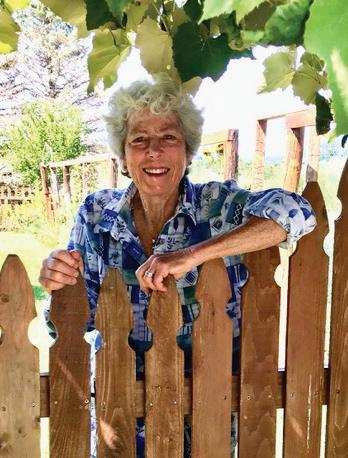
Thursday, November 17, 2022 Page 2 Commentary/Opinion
“Buck on Opening Morning” (2021) Photo, by Taylor Scott
Pictured is the photographer's father and brother with a buck harvested opening day 2021 regular gun deer season.
Submit your artwork or photography for cover consideration: editor@valleysentinelnews.com Cover image traced by
Williams
Pictured above is the view from our Managing Editor's stand in Richland County, opening day 2021 regular gun deer season.
Julianna
Katie Green
Photo contributed by Katie Green Bob and Kate McQuade in their Shoppe.
Our Fragile Democracy — Part 9: The Bill of Rights – the Rest of the Story
Beverly Pestel, Columnist
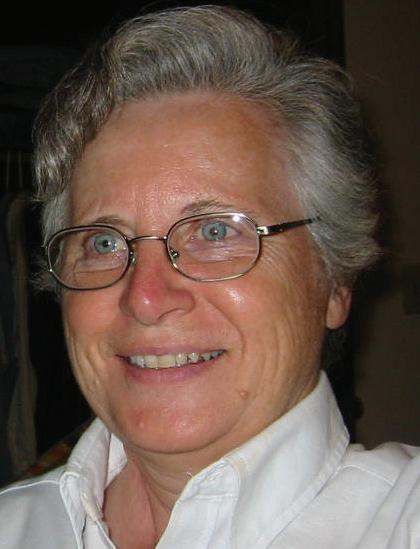
“Our Fragile Democracy” is a series of thought-provoking columns by retired local professor Beverly Pestel exploring the history and struggles of our nation's form of government from its founding to our current social, cultural and political tensions — looking at solutions and means of learning to work with one another, in hopes of preserving our democracy.
So, as covered in Part 8, we have a Bill of Rights that ensures – maybe –protection of the rights of citizens from actions of the federal government. From the beginning, however, there were questions of how these rights would be enforced, interpreted, and applied. Thomas Jefferson and James Madison insisted that a system of independent courts would be “an impenetrable bulwark” of liberty to ensure our rights. The caveat, however, is that the courts have to wait until a dispute is lodged by some person or entity that has something to gain or lose by the outcome. Courts are not empowered to initiate actions on their own. That brings us to the next impediment in enforcing the Bill of Rights. The most common violations of the Bill of Rights – and there have been many - went unchallenged because those whose rights were being infringed were the least aware of their rights and least able to afford a lawyer. The ACLU puts it this way: “The Bill of Rights was like
an engine no one knew how to start.” So, they started that engine in 1920. Along with the NAACP and labor unions, they began to challenge constitutional violations of rights on behalf of those who had been previously left out of those protections.
Then, there is the issue of whether these rights really pertained only to the federal government, not the states as the Supreme Court had determined in 1833. It wasn’t until the Reconstruction Era and the ratification of the 13th, 14th, and 15th Amendments that the issue was
of law; nor deny to any person within its jurisdiction the equal protection of the laws.”

Through a series of Supreme Court decisions in the 1960s, a “fundamental fairness” principle was used to document that nearly all the important provisions of the Bill of Rights apply to the states. So, that issue is solved - but only if the Supreme Court chooses not to reverse precedent?
There is also the issue of how certain amendments within the Bill of Rights should be interpreted and applied. A limit to freedom of speech is often expressed by using the example, you can’t yell fire in a crowded theater. Must we accept, however, that there is no limit to lies that can be told that are detrimental to domestic tranquility and the general Welfare?
Does a somewhat vaguely written 2nd Amendment mean that there must be no infringement on any citizens’ right to own weapons designed for no purpose other than war? Does it mean that we the people have no right to protect ourselves by restricting unstable individuals from keeping and bearing arms?
to argue that right. The strongest Constitutional case for the right of privacy is the 14th Amendment, “no state should deprive any person of life, liberty, or property.” This Amendment encourages the passage of new laws that could flesh out and help strengthen specific rights and afford citizens more specific protections. The Supreme Court reinforced that idea in 1973 with the Roe v. Wade decision which was based primarily on rights of privacy. That court decision, however, was never codified in law by Congress.
And this brings us back to the courts.
The Supreme Court was able to reverse precedent and undo the 1973 privacy protection for women in 2022. It would appear that our “impenetrable bulwark” of liberty so ardently believed in by Thomas Jefferson and James Madison may not be so impenetrable.
The Supreme Court is currently hearing arguments on an extreme gerrymandering case from Alabama that “packs and cracks” the voting rights of Black Americans in that state. Their ultimate decision on that attack against voting rights is uncertain.
resolved, instituting what scholars call the “second founding.” The Fourteenth Amendment reads in part: “No state shall make or enforce any law which shall abridge the privileges or immunities of citizens of the United States; nor shall any State deprive any person of life, liberty, or property, without due process
LETTER TO THE EDITOR
Dear Editor,
The Giant Farmer Puppet of Plain was a huge success with over 2,500 people enjoying weekend performances on the Farm/Art DTour (a biennial event organized by Wormfarm Institute), and thousands more who stopped by during the week. This project was a year in the making, from brainstorming with village community members and artist Christopher LutterGardella last October, to community workshops during the spring & summer of 2022, to countless hours building the farmer itself.
First and foremost, thank you to the Village of Plain, led by Ray Ring and the puppet committee of Sheila Carver, Kendra Schluter, Ashley Olson, Marcia Ring, Tracey Brent, Amanda Ring, Jim Captain, Nicholas Studnicka, Melissa Marx, Pat Price, and Steve Frank for their support, guidance and
engagement throughout the process.
This project could not have happened without the space, equipment, skills, time and labor from Kraemer Brothers. We’re blown away by their generosity and inspired by their skills, ingenuity and problemsolving. Special thanks to Andy Kraemer, Matt Price, Taylor Riek, Tim Price, George Bergman, Dan Portwine, Dan Louis, John Walsh, John Feiner, Ben Ring, Greg Kraemer, Steve Kraemer, and the rest of the crew.
A big thank you also to Kraemer North America who donated materials for the farmer and Bob Neuheisel for his ability to source most any material.
In addition to the farmer, we created nine giant vegetables for the farmer to harvest. Thank you to Kasey Maxwell, TJ Wunnicke & River Valley middle and high school students, and to St. Luke’s Church & the
Have we already given up some of the protections of the 4th Amendment against unlawful search and seizure with the passage of the Patriot Act in 2001? There is no straightforward amendment in the Constitution ensuring the right to privacy, however, the 1st, 3rd, 4th, and 9th Amendments have been used
There will be a number of cases before the (appointed) Supreme Court in the next year. Are these being brought by those who are attempting to weaken a Constitution that through our history has gone through a process of “in Order
LBH missionaries for their help. Thank you to Connie Anderson who helped lead those workshops.
Thanks to Mark Alt for help making the farmer’s seat. Thanks to Ed Liegel and Michael Bindl of Driftless Extracts for use of the field, and for leaving a section of hemp standing for the “stage.” Thank you to Richard Parnell and Alicia Cosnahan who painted the farmer’s clothes and helped with final construction.
Once the farmer was constructed, a whole crew came together to bring him to life!
Thanks to Robert Schlieckau and Tom Riek for driving the forklift during the performances. Thank you to our puppeteers: Chloe, Alex, Wayne, Celia, Ceci, Jack, Maria, Kei, Max, Ray, Al, Ryan, Pat, Kendra, Mary, Sarah and Beth. We could not have done it without you!
Thank you to the dancers who brought
the vegetables to life, especially to Mandy Herrick, AnnaJo Doer, Rufus Jupiter, and Sarah Butler for choreographing, and to our amazing local dancers Braelyn Tafs, Josie Mahoney, Ella Myers, Kenley Straka, Brielle Grant, Gina Klein, Kyllie Smith and Nevaeh Hatfield.
The performances went so smoothly in large part because of the amazing parking attendants. Thanks to Marcia Ring, Mary Brey, Lisa Price, Randy Brey, Larry Blau, Greg Patterson, Craig, and Ray Ring.
Finally, much gratitude to our funders without whom this wouldn’t be possible, especially local support from the Sauk County Arts, Humanities & Historic Preservation Committee and the Wisconsin Arts Board.
Katie Schofield & the Wormfarm Team
Deadlines: The display and classified advertising dead- line is Monday at noon for that week. If you would like our design team to design the ad then please allow extra time for the creative process and proofing.
Ad team: ads@valleysentinelnews.com

Editorial Policy
On certain topics in areas of great community interest, the editors of the Valley Sentinel may take positions they believe best represent and serve the interests of the community. Any opinions or positions taken by the editorial board are separate and distinct in labeling and substance from the community journalism that appears in the rest of the publication and does not affect the integrity and impartiality of our reporting.
Letter to the Editor Policy
and
Submissions must have a compelling local
interest. Letters to the editor must fit within a 500-word limit, and include name, city and phone number. Phone numbers are for office use only and will not be published. Letters of a political nature, without chance of rebuttal, will not be published the week before an election.
Full and up-to-date policies available at: www.valleysentinelnews.com
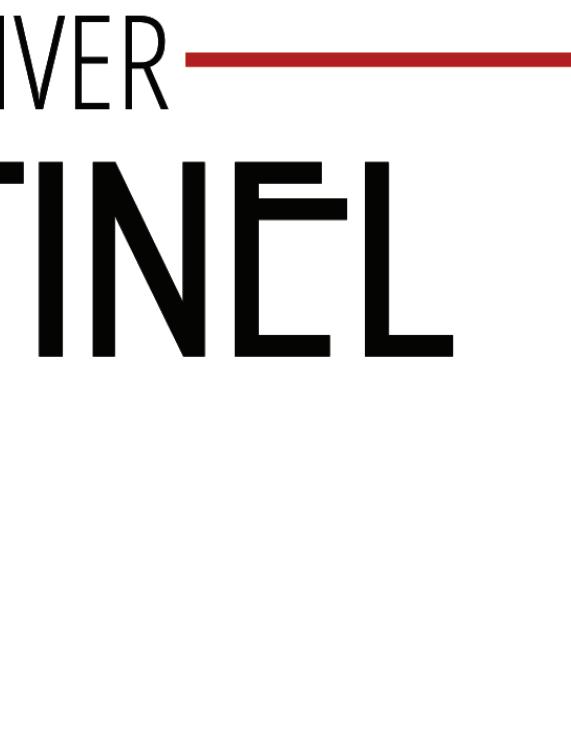
Valley Sentinel is an independent, editor-owned, all-volunteer, free bi-weekly news publication, available on newsstands in the area.
Covering Arena, Lone Rock, Plain, Spring Green and the surrounding areas in Sauk, Iowa and Richland counties.
Subscribe
Want the paper delivered to your home or business? Subscribe online at valleysentinelnews.com/subscribe or subscribe annually with your name, phone number, address and $30 sent to: Valley Sentinel, PO Box 144, Spring Green, WI 53588
Community Discussion Policy
From time to time the editorial board may select letters to the editor of a particular compelling community interest where a public figure or accountable public action is the recipient of criticism and allow, in the same issue, the subject of the criticism chance for rebuttal, with expounded independent input. The format shall be point, counterpoint and expert analysis. This community discussion shall serve as a moderated dialogue that presents multiple views of important community topics.
Valley Sentinel is published in Spring Green, Wisconsin every other Thursday by Lower Wisconsin River Valley Sentinel, LLC. ISSN 2694-541X (print) — ISSN 2694-5401 (online)
Member, Wisconsin Newspaper Association

Thursday, November 17, 2022 Page 3 Commentary/OpInIon
us PO
EDITORIAL Editor-in-Chief Nicole Aimone Managing Editor Taylor Scott Legal Editor Gary Ernest Grass, esq. Graphic Designer Julianna Williams Commentary/Opinion Column Beverly Pestel Commentary/Opinion Column Barb Garvoille Commentary/Opinion Column Katie Green
Contact
Box 144 Spring Green, Wisconsin 53588 USA (608) 588-6694 editor@valleysentinelnews.com valleysentinelnews.com
Policy Editors may feature opinion columns written by public figures, members of the public or other publication staff. Columns reflect the opinions of the individual contributors and do not represent positions of the publication. Guest columns of an anticipated length more than 500 words should seek prior editor authorization.
Column
space
Letters submitted for consideration are subject to fact-checking and editing for
clarity.
community
interested in meetings, events or writing and becoming a community contributor? Let us
Thank you
our
Have graphic design experience or
know.
to all of
contributors for believing in our community.
igne conflatum “Forged in
Est. 2020
Fire”
CONTRIBUTORS IN THIS EDITION
continued
4
Beverly Pestel
on page
Chris Hardie's 'Back Home' column
Observing the rhythms of nature
Chris Hardie, Columnist
The rhythms of nature may change their tune slightly every year based on the weather, but the songs remain the same.
The end of October and early November brings the fall breeding season for deer, also known as the rut. It’s a time of physiological, behavior and chemical changes for deer as well as for bow hunters who make it their preferred hunting dates.
Bucks are seeking doe in estrus and they sometimes throw caution to the wind in their single-minded pursuit of breeding. That makes them move around more and present themselves as easier targets to hunters.
I saw that single-mindedness firsthand recently while driving down a town road a few miles away from home. I came around the corner on a gravel road and a decent-sized eight-point buck started walking toward my truck.
I stopped and took a couple of photos through the windshield and then rolled the window down as the buck – his tongue hanging out – kept walking towards the truck before veering into the woods.
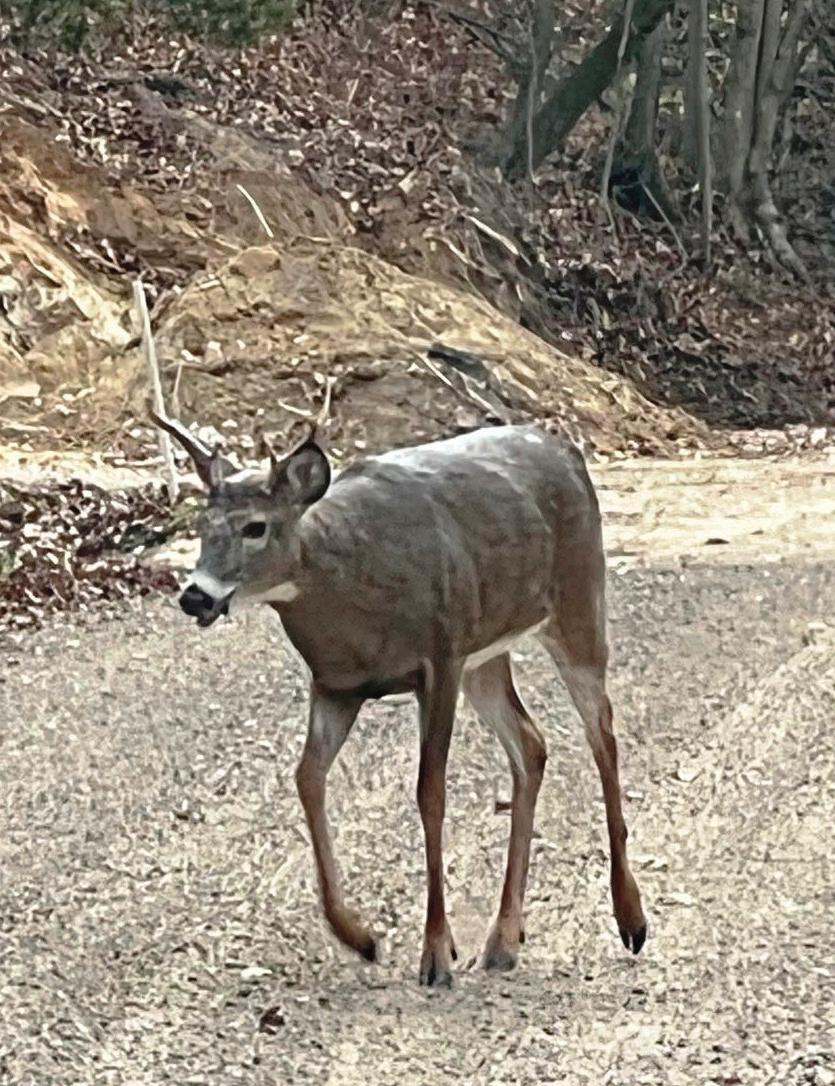
The buck was totally oblivious to the truck and to the classic rock tunes I was playing on the radio. He never raised his tail in caution and had no concerns about me.
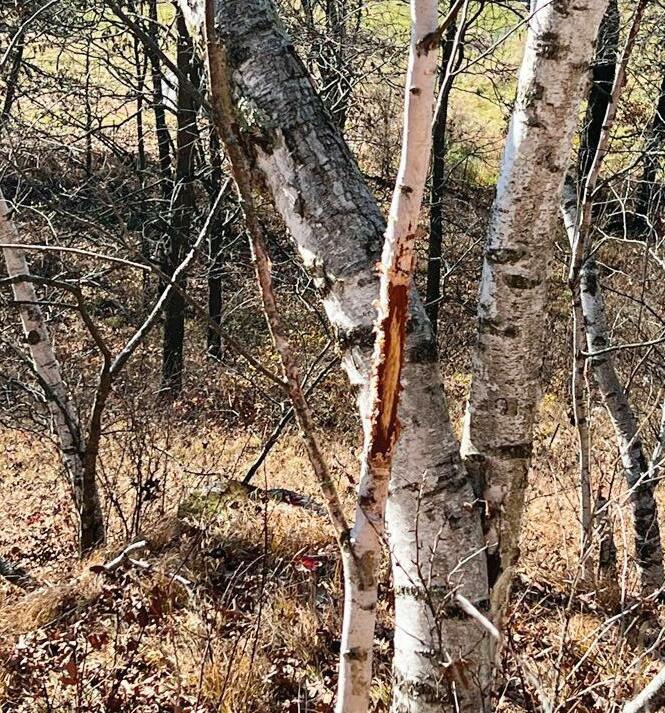
Even when we don’t see bucks, there are other signs of the rut. Bucks like to mark their territory. Rubs are when bucks rake their antlers on brush, small trees or saplings. They peel the bark and leave behind scents from their forehead glands.
Bucks also create scrapes by pawing a bare patch of ground, usually in an oval shape and often under trees. The buck leaves behind scent from a gland located between the toes of their front hooves and will sometimes urinate down the tarsal glands on their inner lower legs for some additional aroma. The overhead branches or the ends of
twigs are where bucks – and does – will chew and lick and deposit additional scent from their forehead and eye glands.
I found evidence of both rubs and scrapes while walking through our woods and creek bottoms. It was in the latter where there were signs of another seasonal occurrence – trout spawning.
Little Creek – the spring-fed waterway that runs through our valley –originates on the farm and is listed as a Class I trout water.
While the creek is too shallow to support trout year-round, it is used by brook trout in the fall for spawning – the process where trout lay eggs. Spawning season is triggered by water temperatures and trout swim upstream from Beaver Creek.
During a recent walk along the creek my wife Sherry and I spotted several trout easily spooked by our steps. The female trout uses its tail fin to make a small depression in the streambed called a nest or a redd and the female and a male will release eggs and milt – or sperm –simultaneously.
The process is repeated upstream with additional redds until the trout is out of eggs. A trout can lay thousands of eggs, depending on its size. The eggs remain in the redds over the winter – kept alive by oxygen from the flowing water.
Then in the spring the small fish –called fry – will emerge. They will stay in the shallow stream seeking food and shelter until they are big enough to need deeper pools.
The ones that survive and grow large enough will return to spawn in a year or two when they are mature.
And nature’s rhythms continue.
Learning lessons from hunting
Chris Hardie, Columnist
Life is measured by the passage of time and the season of deer hunting gives me plenty of moments to reflect on past memories.
This is my 47th year of gun deer hunting and there is no place I’d rather be on the opening morning than sitting in the woods with my back against a tree. I’m carrying on a tradition started by my grandfather and carried on by my father.
I dearly miss both of those hunting partners – Grandpa died in 1994 and Dad passed in 2020. But I feel their presence in the silence of the woods and learned hunting from both of them. Grandpa taught me how to build a ground stand with logs and branches.
He had a fantastic hunting spot that overlooked an open valley between the woods where deer always crossed.
I also copied Grandpa’s nod towards comfort by hunting over a wood fire to keep me warm. Grandpa actually had an old cook stove where I have adapted an old charcoal grill that I have buried in the ground.
Dad taught me patience – sitting in a good spot and waiting for the deer to come could be very productive. But it took me a few years to learn that lesson, as I would easily get cold or bored as a teenager.
That’s when I would take a walk to visit Grandpa, where I knew I could warm up by the fire or even share a piece of lefse. Grandpa had an old butter knife that he jabbed into a punky log on his deer stand. He’d pull that knife out from the log, wipe it on his pants and butter up the lefse.
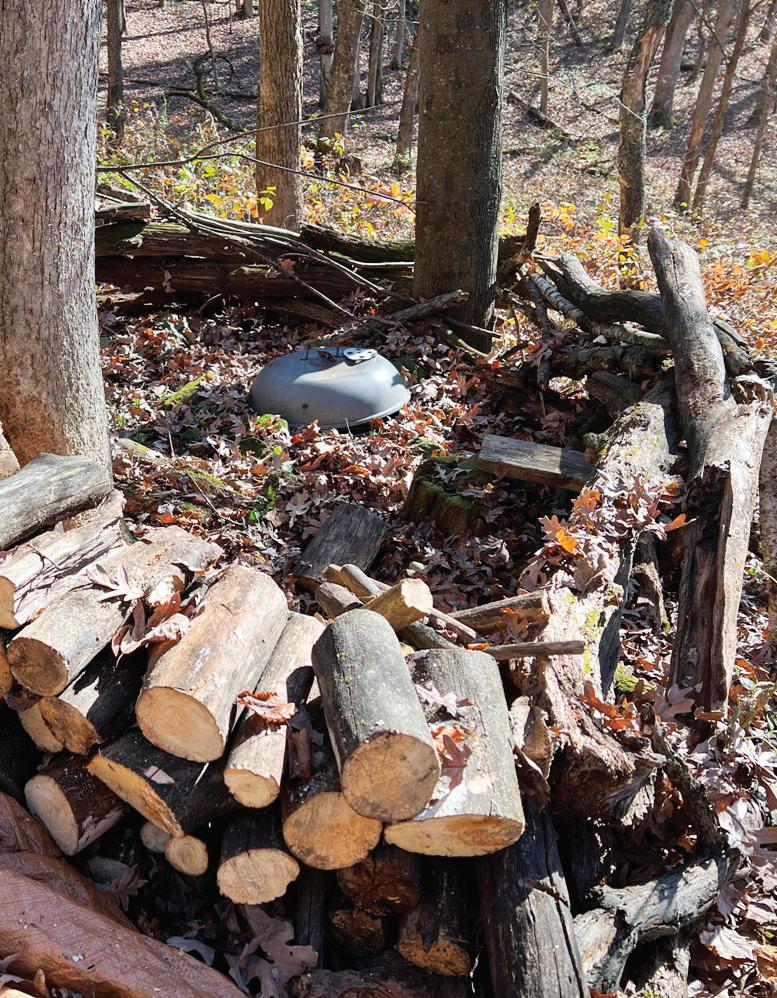
When Grandpa was unable to hunt
during his final years, I inherited his stand for a few years and continued to hunt over an open fire. The stand was destroyed in 1998 when the tree it was under blew down with many others during the straight-line wind storms that year.
Later that year I took a walk through that valley and was amazed at how the storm had altered the landscape. I sat down in the remains of the stand and thought about Grandpa, his stories and the old knife, which I had left in the stand as a tribute to him.
Something made me look down and right under my feet, there it was. The old butter knife, tarnished and bent. I smiled and carried it and its memory with me.

I still have the knife, as well as the Thermos that Grandpa used and one of his old flannel shirts. I wear the shirt the day before the hunting opener and carry the Thermos into the woods every year.

When Dad died, my mother gave my son and son-in-law some of his hunting items. They too can carry the memories and the stories with them.
Last year I had the good fortune of harvesting a big buck. Whether I pull the trigger this year is really not that important to me anymore. Deer hunting is my opportunity to unplug — if only for a few hours — from the hectic pace of life. It’s a time of solitude and reflection.
Hunting has helped teach me some humility, the virtue of patience and a deep appreciation for creation, bundled with the value of tradition and family. And I still have some lessons to learn.
Chris Hardie spent more than 30 years as a reporter, editor and publisher. He was nominated for a Pulitzer Prize and won dozens of state and national journalism awards. He is a former president of the Wisconsin Newspaper Association. Contact him at chardie1963@gmail.com.
Our Fragile Democracy — Part 9: The Bill of Rights – the Rest of the Story
to form a more perfect Union”? Are they attempting to dial back the hardfought rights of those not included in the original “all men are created equal” declaration? A way to correct what may be a not-so-impenetrable bulwark is with new laws passed by Congress – a body populated with our elected representatives. So, the ultimate decisions are – or should be – in the hands of the voters.

Our Founders created a great experiment in democracy, we owe them
a great deal. There may be cause to question some of their choices, but we may want to be careful about judging them too harshly. We cannot know all the backroom arguments, debates and negotiations that were necessary to pull thirteen disparate states into a cohesive union. However, we must be willing to admit that our country was flawed from the beginning, skewed toward white, prosperous men. We possess a Constitution weakened from the start by compromises made to that “certain class of men” intent on preserving the power they held. In addition, a fear of
the tyranny of the majority has left us with loopholes in the Constitution. Have these loopholes been used to move us toward a tyranny of the minority as the white male majority of the 1800s began to see themselves gradually becoming the minority?
The future of Our Fragile Democracy is in our hands. A government cracked, flawed, imperfect, but without a better alternative. We either work to mend the cracks that have been widening or we stand back and watch it shatter. Some Americans gave their blood and lives for the right to vote and move toward a more
perfect union. Did we choose in 2022 to honor that? Did we work to educate the voting populace to the dangers our democracy faces? Protecting our Democracy is our responsibility through our service to our country and our vote. In 2022 have we taken that responsibility seriously enough?
Beverly is a retired professor. She lives in a remodeled farmhouse and tends 40 acres of woodland in Richland County. When not in the woods she spends her time reading, writing and enjoying the beauty of the Driftless Area.
Thursday, November 17, 2022 Commentary/OpInIon Page 4
Photo contributed by Chris Hardie
This birch tree has had its bark scraped off by a buck rubbing it with his antlers.
Chris Hardie
continued from page 3
Photo contributed by Chris Hardie
This 8-pointer was walking down a town road toward Chris Hardie's pickup truck.
Photo contributed by Chris Hardie Chris Hardie's deer stand with a stack of wood for burning in the old charcoal grill.
Photo contributed by Chris Hardie A Thermos, an old butter knife and a flannel shirt all belonged to Chris Hardie's grandfather.
Reflections from Lost Horizon Farm — Milking (cont.)


Each edition, retired dairy farmer Barb Garvoille brings her musings on dairy farm life from her own years of experience on Lost Horizon Farm with her late husband Vince “Mr. Farmer” Garvoille. This mooving memoir focuses on 19802000, join Barb as she rises with the herd.

The Morning Milking
For the milker's safety and the cow's comfort, the cow trainers were turned off during milking. The initial steps in the milking process were to alert the cow to human presence with a calm voice or light hand, walk beside the cow, bend, and spray the teats with sanitizer and wipe each of the four teats with a clean paper towel. The milking unit would then be taken off the cart and the cane end of it inserted into the pipeline. Each of the teat cups would be put in place on the cow's udder, and the milking process would begin. Five repeats of the same procedure would find all six milking units in use with three cows on either side of the walkway being milked. As one cow was nearly finished milking, the person doing the milking would prepare the next cow on that side. The milker would then remove the milking unit from that cow, put teat dip (to prevent bacteria from entering the teat canal) on each of her four teats, and take the milking unit to another cow just prepped. Thinking ahead to the next cow in line, which sometimes was not the next cow in order, took careful mental notation. Cows that were dry were omitted. Any cow that had been treated with antibiotics had to be milked last into a fresh cow bucket and her milk not allowed in any way to commingle with the other milk. Close attention had to be directed to all the cows being milked. Because milking takes a lot of a cow's energy, sometimes a cow would deem herself done or simply tire and lie down right on the milking machine! At other times, a cow would raise her hind leg and kick the machine off. There could be several reasons for this behavior: impatience, orneriness or udder discomfort from a bruise or the onset of mastitis. A machine that had been kicked off had to be cleaned and examined carefully for any debris that could have been sucked into any or all of the four inflations. A piece of corn or small stalk of hay or straw could prevent milk flow. Generally, a teat cup that was plugged would not have enough vacuum to go back on the teat, or it would squawk and tonally alert the milker that something was amiss. Preparing the cow for milking would usually be stimulating enough to cue a cow to "let down" her milk. It would flow from her teats into the milker through gentle and regulated pulsations; vacuum pressure would draw the milk from the milking unit through clear plastic tubing into the stainless steel pipeline, and that would carry it into the glass receiver jar in the milk house.
When the receiver jar filled to a certain level, a sensor would be triggered, and the
milk would be pumped through a stainless steel arm into the bulk tank. The pipeline spanned the length of the barn on either side of the walkway and was positioned 6 feet above the floor with risers over the

doorways. The pipeline sloped one inch for every ten feet as it approached the milk house. The reason for the slope was related to quality control; when the pipeline was washed, the slope prevented any standing wash water.
Moments after the first six cows were being milked, there would be an accelerated walk to the milk house to double check that all systems therein were functioning properly. The vacuum level was eyed (the ideal was 12 pounds per square inch), and the clamp attaching the arm to the bulk tank was checked. O-rings can stretch and wear, and a faulty gasket or broken seal on the arm meant a milk leak, and that meant literally money down the drain.
Milking was a period of multiple tasks and also a time of heightened alert. Besides the rhythm of the milking and the moving of machines from one cow to the next and the ongoing inspection of the milking equipment in the barn and in the milk house, there was the intimate contact with the animals that was the most important factor in noting herd health or in detecting heats. The human voice played a role as well. A gentle touch as well as a gentle tone of voice made for a win-win situation between cow and human.
By the time the last cow had been milked, most of the cows, having been both fed and milked, were laying down. The barn emanated an aura of relaxation and contentment as the milking cart was pulled out of the barn and into the milk house.
The Milk House after Milking
Pulling the milk cart into the milk house signaled the onset of "doing the milk dishes" — the farmer lingo for cleaning up after milking.
The milking units would be sunk in a tub full of soapy warm water to soak in one of the capacious double sinks. The arm going to the bulk tank was unclamped and moved away from the tank. A white filter sock in the arm was pulled out, removed from its position around a long spring and discarded. If visual scrutiny showed a smooth white filter sock, everything was fine. If there was evidence of small white chunks on the sock, everything was not fine. White chunks meant a case of mastitis
somewhere in the herd, and a person would make a mental note to check any suspect cows during the next milking. Sometimes that would not be necessary, because at the time of the next milking, it would be readily apparent which cow had a full-blown case of mastitis just by her swollen and overly pink udder, her temperature, or by her body language.


The infected cow would need antibiotic treatment, and her milk could not be sold. She would wear a bright red band on her rear leg, and her topline would be heavily marked by the orange line of a paintstick. A sick cow had to be milked separately and last, and her milk would have to be discarded for the number of days indicated on the drug’s label. If the mastitis was severe enough for a vet visit, the veterinarian would always glue a brightly colored oval tag to the hide on the cow’s hip that would identify the drug used and the date after which the cow’s milk could safely be sold for human consumption.
Milking units would be taken from their soapy submersion and connected to ports for mechanical cleaning. The exterior portions of the bulk tank, tank arm, sprayers and the milking units were cleaned by hand with soapy water and a brush and then rinsed down with a sprayer. The entire process of cleaning the interior of the pipeline, all of its components and accessories and the milker units was done mechanically during a timed process that had cycles including pre-wash, wash with CIP detergent, rinse, wash with CIP acid and rinse.
The milkman took samples from the bulk tank every time he came to collect the dairy's milk, and quality reports would be issued to the producer after the milk was tested. Milk quality was directly related to sanitation in the barn and, most importantly, to how clean the farm's milking equipment was. A high somatic cell count would tell the farmer that somewhere in the process something was not being cleaned correctly or enough. Then the farmer became a detective. Quality problems could come from a small source such as a scored milker inflation
or aging o-ring to a bit more definitive source such as a hot water temperature not set high enough, a water softener not working properly, or even insufficient water pressure. Investigation by the farmer sleuth could be quite extensive.
Boots carried barn lime, gravel, sand, hay and manure and left tracks of boot crumbs on the milk house's cement floor. A clean milk house was not only required, it was a source of pride at Lost Horizon Farm, so the floor was hosed down following each milking. All wash or waste water from the milk house was either pumped into the gutter from a subterranean holding tank and went out onto the field with the manure, or it traveled past the holding tank through a soil pipe onto a delta well west of the barn. During warmer months, this moist area was mellowed by the cattails and reed canary grass growing in it and was a favorite haunt of Song Sparrows…
Barb has called Lost Horizon Farm, just north of Spring Green, her home for the past 42 years. She is fond of all creatures (including snakes). Her joy stems from being able to be outdoors every day observing and treasuring the plant and animal life on her small piece of this planet. She loved milking cows and is proud to have been a dairy farmer.
Photo contributed by Barb Garvoille
Thursday, November 17, 2022 Page 5 Commentary/AGrIcuLture
A Song Sparrow at Lost Horizon Farm.
Columnist
Barb
Garvoille,
Barb Garvoille
Photo contributed by Barb Garvoille
The Hoard's Creed. Garvoille says: "We heartily agreed with the sentiments expressed!"
Photo contributed by Barb Garvoille Vince Garvoille milking at Lost Horizon Farm.
Photo contributed by Barb Garvoille Barb Garvoille milking at Lost Horizon Farm.
Events for



Saturday, November 19

COmmunitycalendar


COmmunitycalendar
November 18 - December 2
Clyde Community Rummage Sale 8:00 AM - 2:00 PM Clyde Community Center, 6281 State Road 130, Avoca For more information search Clyde Community Center on Facebook Find bargains at this fundraiser for the Clyde Community Center. We will be selling doughnuts, chili, and BBQ. There will be free coffee all day!
Spring Green Farmers Market 10:00 AM - 11:00 AM S230 E. Monroe St., Spring Green Spring Green Farmers Market Is a year-round outdoor market offering seasonal produce, local meats, baked goods and many other wonderful items. Held outside the Spring Green Community Public Library every Saturday morning. Pre-or ders are recommended. Visit our Facebook or Instagram page or email SGFarmersMar ket@gmail.com for a list of participating vendors and their contact into.
CULINARY WORKSHOP: Salmon Three Ways 2:00 PM - 6:00 PM Frank Lloyd Wright Visitor Center, 5607 County Road C Spring Green taliesinpreservation.org $150 per person What is Organic Salmon, and why is it so expensive? This class discusses the different types of salmon on the market today. You’ll learn to cook salmon three ways, prepare accompanying side dishes, and enjoy the fruits of your labor with some complementary hand-selected wines. Age 21+
LIVE MUSIC: Harmonious Wail 2:00 PM - 6:00 PM Slowpoke Lounge & Cabaret, 137 W Jefferson, Spring Green slowpokelounge.com Tickets $15 in advance, $20 at the door Americana flavored Gypsy Jazz on full tilt! Harmonious Wail combines the searing wit, humor and mandolin virtuosity of vintage Jethro Burns performances, the Conti nental panache of Django and charm of Edith Piath inspired vocals to create a unique musical journey.
Sunday, November 20
LIVE MUSIC: Acoustic Jam 1:00 PM - 3:00 PM Spring Green General Store, 137 S. Albany St., Spring Green 608-5880-707, karin@springgreengeneralstore.com, Spring GreenGeneralStore.com Free event All ages welcome! Acoustic Jams will be held on the third Saturday of each month. While the weather permits they'll be held on our back deck. Bring your instrument and play along or come to listen; all are welcome.
WORKSHOP: One for you and one for another 1:00 PM - 3:00 PM . Kauss Art,101 E Jefferson St, Spring Green alikaussadornment.com $90 Make a bracelet for yourself, or for another. Use the power of intention and the stone’s energetics to create a unique and meaningful gift. This is a two part workshop, but feel free to come to just one!
Monday, November 21
YOGA: Yin Yoga 6:00 PM - 7:30 PM . S7163 County Road G, Hill Point . 608.250.0966, lark@radiantspiritretreats.com . Cost varies . Adults only . North of Plain in a private Yoga Studio with vaulted ceilings and large picture windows overlooking 25 acres. Yin Yoga is a gentle, restorative style of yoga in which poses are held for 3-5 minutes, deeply releasing the connective tissue in the body. Join in-person OR virtually (live or via recording). Schedule subject to change, always check ahead.
Arena Historians Harvest Celebration 6:30 PM Grandma Mary's Brisbane Hall, 175 Hwy 14, Arena For more information, look up Arena Historians on Facebook, or call 608-228-0261 The Arena Historians will host a harvest table of home made and locally grown food and invite folks to bring samples of their homemade bread along with locally sourced family favorite foods that pair well with bread such as jams, jellies or other preserves or even local honey. Local storyteller, Cecilia Farran will share "Daily Bread," a true story that takes place at the noon dinner table in her family farmhouse kitchen.
OPEN MIC: A Night of Words 7:30 PM - 9:30 PM Slowpoke Lounge, 137 W Jefferson St., Spring Green slowpokelounge.com An open mic. Friends sharing words. Watch. Listen. Speak. Share. Maybe you have a favorite poem, or passage from a book you’d like to share. Or maybe you write your own and are ready to share it with the rest of us. Maybe you just want to tell a story. Or maybe you just want to listen. It’s all good. Let’s hang out and share words together. Poetry. Stories. Original work and old favorites. This and that. A Night of Words.
Tuesday, November 22
Family Storytime 10:15 AM - 11:00 AM Plain Kraemer Library and Community Center, 910 Main St, Plain kraemerlibrary.org Fun stories, songs, and themed activities each week for children and their caregivers. Stories and songs 20-30 minutes followed by craft/activity. Children under 6 must be accompanied.
Wednesday, November 23
Fall Storytime 10:30 AM - 11:30 AM 234 N. Broadway St, Lone Rock. For more info look up Lone Rock Community Library on Facebook Join us at the Lone Rock library for fall story time and crafts!
Storytime at the Library 10:30 AM Spring Green Community Library, 230 E. Monroe St. Spring Green springgreenlibrary.org (608) 588-2276 Register in advance Join Ms. Grace for storytime at the library. We'll have stories, songs, and fun! We ask that people sign up in advance online, as storytime will not be hosted if less than 3 families sign up. Families are still welcome to attend if they have not signed up, but be sure to check the website or Facebook page to ensure we have not cancelled for that day.
YOGA - Slow Flow Yoga 6:00 PM - 7:30 PM S7163 County Road G, Hill Point 608.250.0966, lark@radiantspiritretreats.com . Cost varies Adults only Slow Flow yoga is a gentle to mid-tempo paced yoga class perfect for both beginners and intermediate yogis. This class will help you reduce stress, increase flexibility, improve posture, relax and rejuvenate.
Thursday, November 24

RUN/WALK: 12th Annual Plain Pilgrimage 8:00 AM Plain Municipal Park, 925 Parkview Avenue For more information, search Plain Pilgrimage on Facebook 5.5K Walk/Run is an out and back route,10.5K Run is a loop run. Both run/walk routes start and stop at the Plain Municipal Park.
Saturday, November 26
Spring Green Farmers Market 10:00 AM - 11:00 AM S230 E. Monroe St., Spring Green Spring Green Farmers Market Is a year-round outdoor market offering season al produce, local meats, baked goods and many other wonderful items. Held outside the Spring Green Community Public Library every Saturday morning. Pre-orders are recommended. Visit our Facebook or Instagram page or email SGFarmersMarket@g mail.com for a list of participating vendors and their contact into.
Christkindlmarkt 4:00 PM - 8:00 PM Park Ave, Plain stlukecatholicchurchplain.com Shop, Dine, and Be Merry in downtown Plain on Small Business Saturday. Visit and support our local businesses for small business Saturday. Most of the festivities will take place at or around the Kraemer Library. Visit Santa, Cookie walk, Childrens Craft Workshop, Horse drawn carriage rides, Quilt raffle, Christkindlmarkt vendors!
Candlelight Shopping at Prairie Flowers & Gifts 4:00 PM Prairie Flowers and Gifts, 126 N. Lexington St, Spring Green springgreen.com Join us for an old-fashioned shopping experience and shop by Candlelight. Refreshments and in-store specials.
Sunday, November 27
LIVE MUSIC: St. Luke Concert 4:00 PM St. Luke Catholic Church, 1240 Nachreiner Avenue stlukecatholicchurchplain.com Music featuring organ, voice, and brass presented free of charge. A free will offering will be collected with proceeds going to UW Children's Holiday Toy Drive.
Monday, November 28
YOGA: Yin Yoga 6:00 PM - 7:30 PM S7163 County Road G, Hill Point 608.250.0966, lark@radiantspiritretreats.com Cost varies Adults only North of Plain in a private Yoga Studio with vaulted ceilings and large picture windows overlooking 25 acres. Yin Yoga is a gentle, restorative style of yoga in which poses are held for 3-5 minutes, deeply releasing the connective tissue in the body. Join in-person OR virtually (live or via recording). Every monday except 10/31.
Open Mic 7:30 PM - 10:00 PM . Slowpoke Lounge, 137 W Jefferson St., Spring Green slowpokelounge.com Join us the fourth Monday of every month for an Open Mic, hosted by Dylan Harris. We’ve got the mics, the plug-ins, the piano - you bring the music! Whether you want to play solo, sing to a back up, or get the band together, this is the place. So come on out and show your stuff, or just support the folks on stage. Either way, we’re making music together! No cover, but tips for our host are always welcome!
Tuesday, November 29
Family Storytime 10:15 AM - 11:00 AM . Plain Kraemer Library and Community Center, 910 Main St, Plain kraemerlibrary.org Fun stories, songs, and themed activities each week for children and their caregivers. Stories and songs 20-30 minutes followed by craft/activity. Children under 6 must be accompanied.
Wednesday, November 30
Fall Storytime 10:30 AM - 11:30 AM 234 N. Broadway St, Lone Rock. For more info look up Lone Rock Community Library on Facebook Join us at the Lone Rock library for fall story time and crafts!

Storytime at the Library 10:30 AM Spring Green Community Library, 230 E. Monroe St. Spring Green springgreenlibrary.org (608) 588-2276 Register in advance Join Ms. Grace for storytime at the library. We'll have stories, songs, and fun! We ask that people sign up in advance online, as storytime will not be hosted if less than 3 families sign up. Families are still welcome to attend if they have not signed up, but be sure to check the website or Facebook page to ensure we have not cancelled for that day.
YOGA - Slow Flow Yoga 6:00 PM - 7:30 PM S7163 County Road G, Hill Point 608.250.0966, lark@radiantspiritretreats.com . Cost varies Adults only Slow Flow yoga is a gentle to mid-tempo paced yoga class perfect for both beginners and intermediate yogis. This class will help you reduce stress, increase flexibility, improve posture, relax and rejuvenate.
Thursday, December 1
Stitch and Bitch 1:30 PM - 3:00 PM Spring Green General Store, 137 S. Albany St. Spring Green springgreengeneralstore.com The Spring Green General Store’s Stitch and Bitch handwork group meets Thursday afternoons weekly. All are welcome.
Teen
Knit Night at Nina’s 6:00 PM - 8:00 PM Nina’s Department Store, 143 E. Jefferson St. Spring Green ninasdepartmentstore.com Every Thursday from 6 to 8 pm. All knitters and crocheters are welcome. Store closed after 5:30 pm.
Friday, December 2
Holiday Light Parade 6:00 PM Through the streets of downtown Spring Green springgreen.com Glitz, Glitter, and Lights - this is a wonderful way to kick off your holiday season...the Spring Green Holiday Light Parade bring you floats from business es and organizations all lit up and ready to put you in the holiday spirit! Fingers crossed that Santa and Mrs. Claus will be able to join us again this year!
Holiday Sing-along 7:30 PM - 9:00 PM Slowpoke Lounge, 137 W Jefferson St., Spring Green slowpokelounge.com John Christensen will host at the piano for this night of sing-alongs to Christmas Carols and other Holiday Classics. Get in the holiday spirit and gather around the piano for a night of song. Special guest players are also welcome! Come out for a night of casual holiday fun! Earlier that night, at 6:00, is the annual Parade of Lights, so come early, grab a warm drink, and watch from our front porch. But early or late, please be aware that Jefferson St will be closed to traffic and parking during the parade.
Thursday, November 17, 2022 Community Page 6
Game Day 4:00 PM - 5:00 PM Spring Green Community Library, 230 E. Monroe St., Spring Green springgreenlibrary.org Come try out video games, board games and more! Designed for middle and high school aged teens.
calendar
WHAT’S HANGINg ? ongoing art exhibitions
Winter Art Market November 26-December 31, 10:00 AM 3:00 PM Alfred Art to Wear Studio, 159 N. Lexington Street, Spring Green . springgreen.com . 18 Spring Green area artists in a boutique setting offering their fine craft and fine art. Fiber, Jewelry, Pottery, Wood, Painting and Photography for your year end shopping and gift giving needs available at Alfred Art To Wear. Full schedule available at alfredart towear.com
CIVICS & SERVICES CALENDAR
Thursday
WE'RE LOOKING FOR
EDUCATIONAL OPPORTUNITY
INTERNS AND
Looking for a challenge?
We are looking for interns/volunteers who want to be in the unique position to learn the nuts and bolts of a news media publication that started from the ground up.
You will have the chance to make an impact at the ground level of a startup and see the effect of your work and ideas carried out with a lot of flexibility, in an environment and creative culture you can help influence and create.
”
Available subject areas:
EDITORIAL/JOURNALISM SOCIAL MEDIA ADVERTISING/MARKETING
We are a new, all volunteer local news source that holds a strong belief that by working to keep our communities informed and engaged on a variety of topics including arts & culture, events, community news and serving as a watchdog for our local governmental bodies, we can help create a strong identity for our community and ignite positive growth and change throughout the area.
Interested? Send us your area(s) of interest and a resume to: editor@valleysentinelnews.com
Internship will be unpaid, interns will be required to sign a FSLA-compliant internship agreement. If credit is available from intern’s educational institution for participation in an internship, we are glad to work with you to meet any requirements for receiving credit.

Want to help build community? Know a college student that’s looking for a summer or fall internship for academic credit or to gain experience? Already attending village board or school board meetings and want to record or report on them? Want to engage with arts & culture, ag, businesses and other topics important to our community? Want to take scenic walks or drives delivering papers to subscribers and businesses?
We have so many ideas to grow and do more for our community, but we need help, we CAN’T do it alone.
If you want to be a part of something bigger please email us and let us know what your interests are: editor@valleysentinelnews.com
-Graphic design (publication layout, visual story design, infographics) -Sports reporting
-Municipal meeting recorders/reporters -School board reporters
-Social media posting/creation -E-newsletter -Website posting -Agriculture reporter/columnist (current events)
November 17-December 21:
Operation Hygiene Barrels for donations can be found across Plain, Lone Rock, and Spring Green Check springgreen.com for the full list of items needed In partnership with the River Valley School District, we are collecting hygiene products for families in need that are in the River Valley School DistrictSeveral Businesses in the area also have "spare change" buckets that will also be donated for hygiene products that the school purchases for students in need.
November 21:
MEETING: Village of Spring Green Parks and Recreation Committee Meeting 7:00 PM Virtual event vi.springgreen.wi.gov November 29:
MEETING: Rolling Hills/Viroqua Toastmasters Bimonthly Meeting 7:00 PM9:00 PM Kelly's Coffee House, 196 West Court Street, Richland Center Please join our members representing communities within 60 miles of Richland Center in an exciting, fast-paced two-hour meeting where we delve into the art of communication and leadership. We meet bimonthly at 7-9 p.m on the second and fourth Tuesdays.
December 3:
Bake and Book Sale: Friends of the Spring Green Community Library 8:30 AM2:00 PM Commmunity Room, Spring Green Community Library, 230 E. Monroe St. Spring Green springgreenlibrary.org Calling bakers to donate baked goods! Drop off Dec 2 from 1-5.
Toy Drive for Children spending the holidays at UW Children’s Hospital 9:30 AM - 5:00 PM Plain Kraemer Library and Community Center, 910 Main St, Plain Donate Toys, cozy blankets, holiday PJs, holiday socks, items to decorate the children's rooms during the holiday season, IV bag covers (some kids needing transfusions are scared seeing a bag of blood), pillowcases in cute fabrics or with holiday fabrics. We will collect all donations and donate them to American Children's hospital in Madison.
December 4:
MEETING: Coon Rock – Join 4H! 5:00 PM Arena Fire Station, 111 David Cir, Arena Develop positive relationships with peers and adults, be actively involved in their own learning, contribute as active citizens through service and leadership,and much more!
The Community Calendar is curated and designed by Julianna Williams. Events are subject to change, always check ahead for up-to-date information on any events you are interested in.
Want to be the first to read Valley Sentinel?
We’re looking for help distributing the paper!
We can’t thank those who have recently stepped up to offer to help enough, thank you!
Paper Distribution Routes

Arena Subscribers: COVERED
Arena Businesses: COVERED
Lone Rock Subscribers: COVERED
Lone Rock Businesses: COVERED
Plain Subscribers: AVAILABLE
Plain Businesses: AVAILABLE
Spring Green Subscribers: AVAILABLE
Spring Green Businesses: AVAILABLE
Clyde Community: AVAILABLE Rural Routes: AVAILABLE
Want to enjoy scenic drives or a walk around town and assist in connecting our businesses, subscribers and community? Whether for fun or for volunteer experience, just one village, route, or more, we’d be happy to have you!
Interested?
Email: editor@valleysentinelnews.com or call 608-588-6694
M A R K E T I N G | A D V E R T I S I N G | P A R T N E R S H I P C O N T E N T B U S I N E S S I N S I D E R UPCOMING SPECIAL SECTIONS/EDITORIAL NOTES: December 1: Local Holiday Gift Guide (Special Section) – Our annual catalog listing of local gift options. First listing free for area businesses, additional listings only $15 each. All other advertising options available as well. Inquire if interested. December 15: Blaze Orange Board (Special Section) – Our annual juried brag board of trophy (and otherwise) deer and views out in the field from the season. Yes, we know the antlerless-only holiday hunt won't be over yet. But are you going to sit freezing in your stand for a big doe over the holidays? We didn't think so. January 12, 2023: Winter Wonderland (Special Section) – Our annual winter special section of cold activities and events to break us out of our winter doldrums. Have ideas for Winter After Dark events? Let us know! January 26, 2023: Romantic Resources (Special Section) – MAY BE MOVED TO FEBRUARY 9 – Our annual Valentine's Day area resource guide. All special sections subject to change and participation. The more support and engagement we get, the more we can offer
Bake and Book Sale: Friends of the Spring Green Community Library 8:30 AM2:00 PM Commmunity Room, Spring Green Community Library, 230 E. Monroe St. Spring Green springgreenlibrary.org Current Friends members can shop at 8:30. Open to the general public at 9:00. Not a member? You can join that morning! Home made baked goods, Gently used books, DVDs and puzzles.
the community together.
— OPPORTUNITIES IN ALL OF OUR SPECIAL SECTIONS — Presenting Sponsor of the section — $400 (1 available each special section)
A presenting sponsorship grants your logo and business name on the section itself. A sponsorship also includes a banner ad to be run within the section. Sponsor will also receive half off any sponsored article content within the special section.
Supporting sponsorships of special sections may be available at $200 for all benefits above, excluding banner (limited availability), but also including 50% off ads in the section.
Featured Business/Sponsored Articles — $200 for 1/2 page promotional article with 1-2 pictures ($100 if sponsor for the section) – Limited availability. Runs online as well.
— Advertising Spots —


$400 full page, $200 half page, $100 quarter page, $50 eighth page, $25 sixteenth page – Limited availability. Inquire about sponsorships, partner content and online and social ad opportunities.

More information: valleysentinelnews.com/advertising-businesses

November 17, 2022 Page 7 Community
,
GRAPHIC DESIGN/PAGE DESIGN/LAYOUT DISTRIBUTION/CIRCULATION/CRM MNGMT PODCASTING/AUDIO PRODUCTION
AND MORE! COMMUNITY CONTRIBUTORS
Areas in most need:
We have the infrastructure set up for most of these areas, we're just in need of manpower from passionate community members.
Local Art at the Library: Donn Lind and Peggy Timmerman Monday-Thursday: 10 AM - 7 PM Friday: 10 AM - 5 PM Saturday: 9 AM - 1 PM Spring Green Community Library, 230 E. Monroe St., Spring Green Donn Lind is exhibiting his woodcraft in the Glass Case Gallery at the Spring Green Community Library. Donn’s Pinedune Wood Goods are Spring Green Community Library. Donn’s Pinedune Wood Goods are available for viewing during regular library hours. available for viewing during regular library hours. available for viewing during regular library hours Peggy Timmerman is showing her calligraphy and painting in the Community Room Gallery. This exhibit is available for viewing at any time during regular library hours when the room is not already in use.
For everyone asking “where have all the Bridge and Cribbage clubs gone? (those go in our general community calendar, but nice try), “why won’t any young adults attend village board meetings?” and “how do I get more people at my service organization meetings?” — this is the calendar for you! This calendar will be a place listing (for free) the typical meeting dates for area governmental bodies, Please email us with these meetings, or use the form on our Community Calendar page — and let's build community together: editor@valleysentinelnews.com

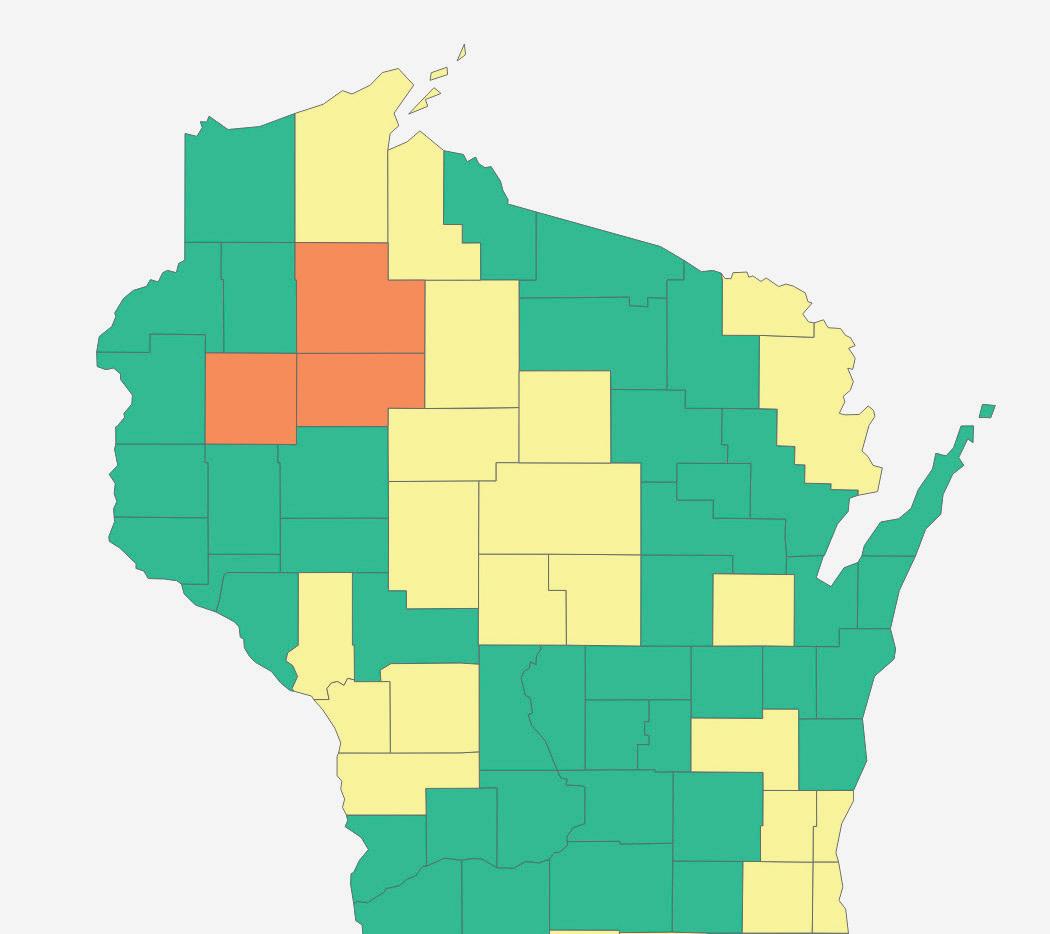





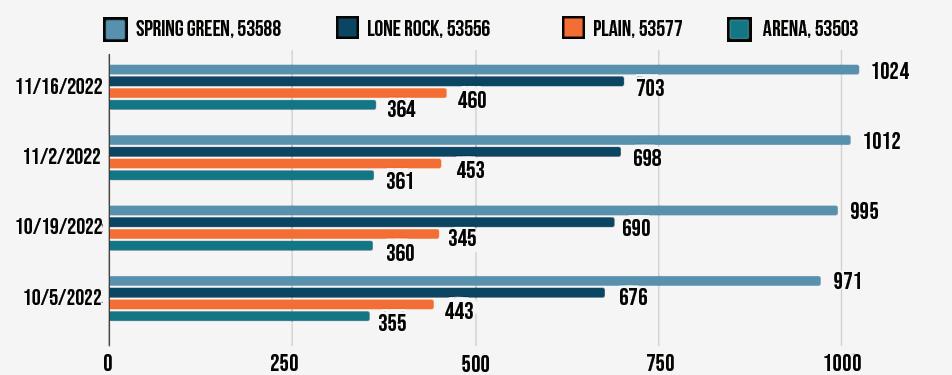

Thursday, November 17, 2022 Community Page 8 “The good stuff .” COVID-19 Dashboard Wisconsin Summary Cases as of 11/16/2022 Cases as of 11/16/2022 Graphic by juliAnna Williams 1,681,520 Positive Cases +10,170 from 11/2 +49 from 11/2 Percent of Wisconsin residents ages 5-11 who have completed the primary series by county Vaccine Summary Statistics Vaccine Data 61.8% 37.3% 65.7% of Wisconsin residents have completed the vaccine series of Wisconsin residents have received an additional booster / dose Updated: 11/16/2022 Updated: 11/16/2022 Updated: 11/16/2022 Ages 5-11 12-17 18-24 25-34 35-44 45-54 55-64 65+ Cases per zip code Percent of Wisconsin residents who have completed the primary series 13,714 Deaths Data From: https://www.dhs.wisconsin.gov/covid-19/index.htm +34 from 11/2 +0 from 11/2 4,767 Positive Cases 53 Deaths Richland County Ages 5-11 Ages 5-11 Ages 5-11 Ages 5-11 17.9% 31.2% 24.6% 58.6% Higher % Lower % Richland County Iowa County Sauk County Dane County +178 from 11/2 +2 from 11/2 19,975 Positive Cases Sauk County 152 Deaths +0 from 11/2 +58 from 11/2 6,560 Positive Cases 31 Deaths Iowa County Iowa Percent completed the primary series Percent received the updated (bivalent) COVID-19 booster Sauk Percent completed the primary series Percent received the updated (bivalent) COVID-19 booster Richland Percent completed the primary series Percent received the updated (bivalent) COVID-19 booster 27.6% 59.5% 56% 60.7% 66.5% 69.4% 75.9% 81.8%
case
county level weekly
Updated:
786,616 3,605,856 Wisconsin residents have received an updated booster of Wisconsin residents have received at least one dose Wisconsin residents have completed the vaccine series 0-4 2.2% 16% 57.8% 67.7% 17% 15.5% 62.8% Updated:
covid
activity level Updated: 11/16/2022 This map shows the current CDC COVID-19 Community Level for each county in Wisconsin. Community levels measure the impact of COVID-19 illness on health and health care systems in communities. COVID-19 community levels can help communities and individuals make decisions based on their local context and their unique needs. Community vaccination coverage and other local information can also inform decision-making for health officials and individuals. Updated: 11/16/2022
statistics
11/16/2022
11/16/2022
Richland County Column — County Board Moves Forward with Budget Cuts
Here is my latest update on the Richland County Board of Supervisors.
County Board Moves Forward with Budget Cuts
Since I last wrote this column, the County has been busy balancing the budget for the next 5 years (2023–2027), which currently requires approximately $4.5 million in cuts or additional revenues.
Actions below show how the County Board voted at our August 16th meeting in comparison to the Administrator’s original proposals in June. Any dollar amounts in parentheses are annual property tax contributions.
Resolution 22-90
• Concurred with the recommendation to develop a plan by June 2023 to separate the County from Richland County Ambulance.
Resolution 22-91
• Declined the potential sale of Symons Recreation Complex, but replaced it with a directive to explore the possibility of transferring Symons to a non-profit organization ($34,000).
• Declined eliminating the County’s $73,000 contribution to Economic Development, but replaced it with a directive to explore the possibility of private sources covering 50% of the cost, similar to Green County ($37,000).
Resolution 22-92
• Declined developing a plan to contract all services at Pine Valley Community Village and subsequently sell the building and grounds, but replaced it with a directive to explore the possibility of increasing profits. The profit goal was set at 50% of mortgage payments (increasing the amount from $300,000 to $740,000).
Resolution 22-93
• Declined the potential sale of the Richland County fairgrounds, but replaced it with a directive to explore the possibility of transferring fair operations to a non-profit organization, similar to the Vernon County Fair ($15,000).
• Declined eliminating the County’s $30,000 contribution to Richland County Parks.
Resolution 22-94
• Declined the potential sale of the
UW-Richland campus, but replaced it with a directive to explore the possibility of returning admissions and recruiting from UW-Platteville back to our campus, as well as a $100,000 annual maintenance contribution from the UW-Richland Foundation matching an annual
Clerk, County Board, and Treasurer Departments from $200,000 to $383,000 by 2027 (out of a current $890,000 property tax contribution). I voted in favor of all resolutions as amended because they did two things: 1.) they balanced the budget, 2.) they spread the cuts more evenly across departments. Some of you are probably wondering how the County got into the position of needing such large cuts. I see four main reasons:
1. The State of Wisconsin wants counties to grow slower than the economy by restricting our ability to raise property taxes for operating. They only allow those taxes to go up at the same rate as new construction. In Richland County, this is about 0.5% per year. Over the past 10 years inflation has averaged 2.5% (including the current inflationary rate of 8.3% for 2022).
complex. But the total cost of those extras are a drop in the bucket compared to the total gap we will experience over the coming five years.
I believe we have to be very serious about the resolutions listed above. Many departments are saying “we can’t make these cuts.” But we really have no choice –we cannot comply with state policies, give wage increases, and keep up with rising health insurance costs unless we downsize. There appear to be only two major “outs” from this scenario:
1. We can ask the State of Wisconsin to a.) amend their policy that the County grows more slowly than the economy and b.) return our fair share of income and sales tax revenues they collect to our county government.
$100,000 maintenance investment by the County.
• Amended the proposal to reduce the UW Extension budget from $185,000 to $85,000 (a reduction of $100,000), to reduce it from $185,000 to $148,000 (a reduction of $37,000).
Resolution 22-95
• Concurred with reducing the property tax contribution to the Land Conservation and Zoning Departments from $195,000 to $145,000 (a reduction of $50,000).
Resolution 22-96
• Increased cuts to the Health & Human Services and Veterans Departments from $350,000 to $1 million by 2027 (out of a current $2.48 million property tax contribution).
• Increased cuts to the Sheriff, District Attorney, Clerk of Court, Register in Probate, Coroner, and Emergency Management Departments from $350,000 to $1.67 million by 2027 (out of a current $4.12 million property tax contribution).
• Increased cuts to the Highway, Management Information Systems, and Courthouse Maintenance Departments from $350,000 to $870,000 by 2027 (out of a current $2.16 million property tax contribution).
• Increased cuts to the Administrator,
2. The State of Wisconsin is sharing fewer tax revenues with Richland County (going from $1.36 million in 2001 to $1.22 million in 2021), not giving inflationary increases and forcing us to shrink further.
3. After comparing wages for select County positions with other counties, it is apparent that many Richland County employees are the lowest paid, and they need annual pay increases. Over approximately half of the last 10 years, our employees have not seen annual wage increases. We are losing employees because of this, and it is hurting the quality of services (e.g., Sheriff’s, Highway, Health & Human Services, Pine Valley Community Village) you receive.
4. Health insurance is costing us more every year, rising faster than inflation. These are our largest costs after wages, and as a result we have increased employee premiums and deductibles and have reduced the portion County government pays. Many people have suggested “this department” or “that department” needs to be cut to solve the County’s budget woes. The truth is that to keep up with the reasons listed above, pretty much all departments have to downsize. Another suggestion has been to eliminate all the “extras” like the fair, parks, campus, economic development, and recreation
Statewide Birding Report: Goodbye Fall Migration, Welcome Wintering Birds
Winter-like weather has finally arrived, bringing the tail end of bird migration season that we’d expect this time of year. Tundra swans are being seen by the hundreds now at traditional areas along the Mississippi River, Goose Pond in Columbia County and the vicinity of Green Bay. Numbers will build until ice cover forces them eastward to mid-Atlantic wintering grounds. Other waterfowl are plentiful now as well, including a variety of divers and dabblers at most water bodies.
Large numbers of red-breasted mergansers were seen recently migrating south off the Lake Michigan shore, highlighted by 10,000+ at Manitowoc on Nov. 12. Lake Michigan is also a great location for spotting long-tailed ducks and all three scoter species. Some loons continue to be seen, but peak numbers have passed. Greater yellowlegs made their usual last pass through the region in the first half
of the month, as did a few long-billed dowitchers, dunlin and Wilson’s snipe, but expect few to linger now.
The first snowy owls have arrived, though only in very small numbers at this point. Open habitats now host rough-legged hawks by day and some short-eared owls at dusk and dawn, among the more common species like red-tailed hawks, northern harriers and American kestrels. Look for northern shrikes and snow buntings in these areas as well. Golden eagles have arrived in wintering areas in the Driftless Area of western Wisconsin. Bald eagle numbers are increasing too as cold and snow begin to push them southward out of Canada. Big flocks of Sandhill Cranes were reported from many agricultural and wetland areas, some migrating out of the state with the past few days’ cold northerly winds.
Perhaps the fall’s biggest bird news so far is an irruption of evening grosbeaks


statewide and across the eastern United States. Flocks are unusually common across the north woods and some have reached southern areas like Milwaukee, Madison and Chicago. This author had the pleasure of tallying over 1,000 individuals as they actively migrated along the Lake Superior shore on Nov. 3. Look and listen for them at natural tree seeds like ash, boxelder and maple, or attract them to your yards with open platform feeders, sunflower seeds and a water source. Other winter finches are only slowly moving into the north woods, including pine grosbeaks, common redpolls, red crossbills and pine siskins. Purple finches and redbreasted nuthatches are showing well in the south, while blue jays are particularly numerous in the north this year. American goldfinches are plentiful statewide. Rare birds spotted recently include sharp-tailed sandpiper in Manitowoc county, lark bunting in Ozaukee and brant
Arena Historians to hold Harvest Celebration with storyteller Cecilia Farran
continued from page 1
the bread which he so loved.
Cecilia says “I am happy to share this story at harvest time as a way of
connecting to the land and those who have gone before.”
Steve Harrington, historian president says “It is said of Cecilia that she is ‘One heck of a storyteller.’ So happy to
have her share this beautiful story as we gather in community to share the bountiful life of the land.”
Throughout the evening guests are encouraged to mingle and share their
2. We can place a referendum question on the ballot to ask voters to increase property taxes for operating.
The Referendum Ad Hoc Committee was formed in July 2022 by the County Board to investigate that second possibility. I am chairing that committee. We have issued a press release and are digging deeply into the County’s finances, separating cuts into two buckets: 1.) permanent cuts, 2.) cuts that voters could reverse by passing a referendum to increase property taxes.

You can watch videos of our meetings and read our reports to learn more about Richland County government finances at: administrator.co.richland.wi.us/minutes/ referendum-ad-hoc-committee.
In the meantime, please keep sharing your opinions with me so that I can stay informed on the viewpoints of the people.
Health Needs Assessment
The Health & Human Services Department is currently completing a health needs assessment for Richland County. You can attend a “health prioritization” meeting on December 5 between noon and 3 p.m. at the White House, 1450 Veterans Drive, Richland Center. RSVP to rose.kohout@co.richland. wi.us.
Shaun Murphy-Lopez is the Richland County Board Supervisor for District 2 and Vice Chair of the County Board, as well as serving in leadership roles on multiple committees. He can be reached at shaun.murphy@co.richland.wi.us or 608-462-3715.
in Door. Others of interest were parasitic jaeger in Racine; Ross’s geese in Ashland, Milwaukee and Sheboygan; cattle egrets most notably in Lincoln and Dunn; and harlequin ducks in several Lake Michigan counties, including the long-staying and strikingly-plumaged males in Sheboygan. A few Baltimore orioles linger and any late hummingbirds should be photographed and carefully scrutinized now. Two exceptional finds lately were Anna’s hummingbird and Mexican Violetear.
stories and memories. The event is free and open to all but donations are warmly accepted for the Arena Food Pantry. Info at 608-228-0261 or FB Arena Historians.
Thursday, November 17, 2022 Page 9 Commentary/OpInIon
Ryan Brady, DNR Natural Heritage Conservation Program Biologist
Shaun Murphy-Lopez, Richland County Board Supervisor
Shaun Murphy-Lopez
Photo by Ryan Brady Once elusive evening grosbeaks gather.
The Sauk County Gardener
November Tasks

swirls, and the wind hurries on... A tree tries to argue, bare limbs waving, but there is no detaining the wind."
― Aldo Leopold
I spent the first weekend in November enjoying a Badger game and then attempting to finish harvesting the last of my garden produce. With the warm weather, I’m still picking lots of broccoli and kale. I finally picked the Poblano peppers and some tomatoes in my greenhouse. I haven’t yet harvested my Brussel sprouts. I know I will have to soon but maybe I can wait until Thanksgiving and serve them for dinner. I should be done with most of my garden tasks, it’s been hard
Be Grateful and Give Thanks
“Don't wait until the fourth Thursday in November, to sit with family and friends to give thanks. Make every day a day of Thanksgiving!”
— Charmaine J. Forde
This past weekend I had the great fortune to spend time with most of my extended family – we did craft projects, played some games, and of course, had an abundance of delicious food. It was like Thanksgiving had arrived early – it was wonderful. At times like this and as Thanksgiving approaches, I like to look back and reflect on all that I have to be grateful for in my life. Here are just a few of those things.
I’m so grateful for my abundant garden. At times it drives me crazy because so many times it seems my garden produce all comes in at once and I’m scrambling to process all of it. Our freezers and downstairs pantry are full of frozen and canned produce from our garden. We not only have enough for ourselves for the
for me to complete all of them as I’ve been trying to enjoy as much of the nice weather as possible. However, the more frequent winds remind us that winter will eventually arrive and there are some tasks you’re going to want to get completed before it gets too cold to work outside comfortably.
Take time to prepare the soil for any new perennial beds so they are ready to plant next spring. Once the ground finally freezes, mulch perennial beds with shredded leaves or other coarse material. Take care if you have self-sowing annuals in those beds or elsewhere to not smother them with heavy mulch. Clean out window boxes and outdoor planters and fill them with seasonal greens and berries


In the vegetable garden, finish cleaning up the garden and disposing of garden materials on your compost pile. If you
year, but we also have plenty to share with our children and other family. I’m also thankful for the opportunity to learn more about extending the gardening season by planting some peppers and tomatoes in our new greenhouse. It’s really kind of cool to be harvesting tomatoes in November.
I’m thankful for my fellow master gardeners. Over the past few years, our group has been experiencing diminishing numbers, but we still have been able to accomplish big things. We were able to teach at several local schools and help them to continue to develop their school gardens. We also presented several demonstrations at the Sauk County Fair and create a small demonstration garden there as well. We were able to successfully host our first-ever garden tour of ten local gardens in the Baraboo area. It was a lot of work, and this small team of master gardeners were up for the challenge. It was so successful that the Sauk County Master Gardeners Association is planning their second garden tour for July 2023.
have diseased plant material, take care not to put it on the compost pile as it will only harbor the diseases until next year. Mulch the asparagus bed with chopped leaves or straw to protect the crowns. My strawberries are interplanted with my asparagus, so they get mulched at the same time. Harvest the last of hardy vegetables such as Chinese cabbage, Brussel sprouts, and kale. These can continue to produce until a hardy frost below 25 degrees. Carrots, parsnips, and leeks can remain in the ground for winter harvesting if you mulch them with about a foot of straw. Don’t forget to mark their location though. Drain the gas from your tiller and lawn mower after their last use for the season. Finally take soil samples for testing if you haven’t done it in a few years. Cut back any summerbearing raspberry or blackberry canes
This group of gardeners continually looks for ways to share their garden knowledge with their area neighbors and make our community a better place to live. I’m grateful for my family who enjoys gardening and sharing their gardening extras with me. I’m grateful for our daughter and her family as they really have embraced gardening at their home, giving me one more thing to share with them. We are regularly swapping plants and discussing our successes and failures. I’m thankful for our non-gardening son and his family. They humored me by taking care of two large heirloom tomato plants that I “gifted” them this year. (I told them that as a master gardener, I couldn’t have our children not having any garden plants.) They kept the plants watered and harvested numerous tomatoes. I’m also thankful my son and daughter-in-law lets our grandson spend every Wednesday with me. Most of our time is spent in the garden and our grandson loves to eat produce straight from the garden, water the plants, and
that fruited this year.
If the ground is dry, water your trees, shrubs, and especially evergreens deeply before the ground freezes. Prop up any heavy evergreen branches to prevent snow damage. Wrap young trees, including fruit trees, and other woody plants to prevent rodent damage. You may prune Hydrangeas paniculate cultivars (ie. hardy, peegee and Limelight hydrangeas) in the fall once they are fully dormant to minimize the stems from breaking from heavy ice or snow. I tend to leave mine so the dry flowers provide some winter interest. Mulch azaleas and rhododendrons with shredded leaves or pine needles. Soon enough, the wind and snow will come and you’ll be glad to have these tasks done and your garden ready to recoup over the winter. I know I’ll be ready!
explore the various bugs and other critters in the garden. He is well on his way to becoming a master gardener himself. Finally, I am so thankful and very blessed for my husband and gardening partner, Scott. He’s always willing to help with all our gardening projects – except weeding. He’s drawn the line at weeding – that’s the one job I do alone. However, he digs all the big holes, selects and plants all the various trees and shrubs, and has helped create the beautiful yard and gardens we now enjoy today. I’m so grateful he enjoys spending time with me in our gardens.
As Thanksgiving approaches, many of you will gather with friends and family; I hope you will take the opportunity to reflect on what you are grateful for in your life and give thanks.
If you have any gardening questions, please contact the Extension Sauk County by emailing to trripp@wisc.edu or calling the University of Wisconsin Madison Division of Extension Sauk County office at 608-355-3250.


Seeking office space
Valley Sentinel is seeking office space to rent or purchase in the downtown area of Spring Green before the end of the year.
Flexible ideas for the space include a newsroom, co-working space for small businesses and entrepreneurs, local retail/consignment, local art exhibition/gallery space and (eventually) working collaboratively with area businesses to provide extended hours coffee and potentially grab-and-go food.
Please let us know if you have any vacant or soon-to-be vacant commercial space, know of any space, or have any creative ideas or partnership opportunities, by phone at 608-588-6694 or by email at editor@valleysentinelnews.com.
We also currently have indoor publication racks available for businesses that would like them.
Thursday, November 17, 2022 Outdoors Page 10 •Natural double shredded oak bark mulch •Colored decorative mulch Red-Brown-GoldOrange •Other landscape supplies available! Gravel-Boulders-Screened Topsoil-Sand, etc. Jand J We offer complete landscape and lawn care service •Full Landscaping from start to finish •Lawn Mowing •Plantings •Grading & Seedings •Bark Spreading •Limestone & Boulder Retaining Walls Total Lawn Care and Snow Removal •QualityWork •FullyInsured •FreeEstimates SatM-F8am-5pm 8am-noon James Harwood •608-588-2453• E4792 Kennedy Rd. We’reyour onestop shop! Business/Professional Directory Reserve a spot in our business/professional directory! Add $30 to any ad order or $60 as a stand-alone order and you’ll be added to the next edition’s premium placement business/professional directory. Bigger than business card sized, full color, updated annually or for a flat $25 design fee. Perfect for top-of-mind awareness, runs under an attention-grabbing header. Want to run it every edition at a discounted rate? $750 for 6 months, $1000 for 1 year (36% discount)
that makes music
corn
"The wind
in November
is in a hurry. The stalks hum, the loose husks whisk skyward in half-playing
Jeannie Manis, Wisconsin Certified Master Gardener
Jeannie Manis, Wisconsin Certified Master Gardener
CLASSIFIEDS Tutoring Available Recently retired elementary teacher available for tutoring. Call Dawn (608) 225-4751 to personalize how to best support your child.
2022 SEASON DATES
ARCHERY
The Farmland Zone DMUs experienced another mild winter. Although antlerless harvest declined across much of the Farmland Zones in 2021, this was likely influenced by factors other than a notable change in deer numbers. Increasing the antlerless harvest in many farmland counties is important to the long-term health of the deer herd. For this reason, the issuance of multiple antlerless permits with each license, and participation in the December holiday hunt and January season extensions continues to grow. Sharing venison with those who do not or cannot hunt themselves and making a donation through the Deer Donation Program are great ways to help meet antlerless harvest quotas in these counties.
For a complete overview of all deer hunting rules, including changes for this season, please check the 2022 Wisconsin Hunting Regulations available online or at hunting license vendors.
For additional information, visit dnr.wi.gov and search “deer.” There, you will find an abundance of helpful information, including FAQs, maps, resources to help find a place to hunt and more.
NEW FOR 2022
2022 DEER SEASON FORECAST
A total of 37 counties will offer the Dec. 24 to Jan. 1 Antlerless-Only Holiday Hunt. The archery and crossbow deer seasons have been extended in 29 counties to close Jan. 31, 2023. See the map on page 5.
Baiting and feeding regulations have changed in select counties. For more information, visit dnr.wi.gov and search “baiting and feeding regulations.”


Some Farmland Zone counties have
True to the nature of hunting, the 2022 deer hunting season forecast is a mix of local opportunities surrounding a relatively stable buck harvest. The varied landscapes of Wisconsin support diverse deer population densities within each management zone and unit. Wisconsin deer hunters should remember that the following forecasts will vary according to forage, cover and hunting pressure. These variables will influence the presence or absence of deer, or at least their movements during open hunting hours.
2022 REGIONAL FORECASTS
Southern District
Across the Southern District, wildlife biologists are eagerly anticipating the time honored tradition of Wisconsin’s deer season. Last year’s combination of mild winter conditions and decreased antlerless harvest should create increased opportunity for well-positioned and prepared hunters this fall. Although spring was slow to start, comfortable temperatures and adequate rainfall has resulted in a vigorous spring green-up that should provide ample cover and high-quality food for does that are nursing fawns and bucks during antler development. In addition, antlerless harvests have been below recommended levels during the last couple of years, and highly productive farm ground continues to support high deer numbers throughout much of the Southern Farmland Zone. On behalf of the Wisconsin DNR, we’d like to wish everyone a safe and successful hunting season. We hope you have some time this fall to get outdoors and enjoy the beauty and world-class hunting opportunities that Wisconsin offers. Even with such favorable conditions, hunters need to remember that there is great variation in habitat quality across the landscape. As a result, the number of deer inhabiting individual properties can vary significantly. Habitat management remains very important, even in highly productive regions like southern Wisconsin.
Getting out in the field for sense of local prospects is an important and enjoyable part of the hunt. The DNR offers resources on dnr.wi.gov to help hunters get prepared, from public land mapping tools to recent harvest data trends to resources for CWD testing. Don’t hesitate to call your county wildlife biologist to check in on what things are looking like from the field this year.
Eric Canania, DNR Deer Biologist Eric.Canania@wisconsin.gov
DEER MANAGEMENT ZONES AND UNITS
Wisconsin has four deer management zones (DMZs) divided into 77 deer management units (DMUs). DMUs follow county boundaries in most cases, and 10 counties are split by zone boundaries into separate Forest and Farmland DMUs. Antlerless deer permits are set at the DMU level, allowing for localized deer herd management.


The Southern District encompasses a wide range of deer habitat types. They range from the high wooded ridges and coulees in the southwest to the flat, productive farmlands of the southcentral, all the way to the highly urbanized landscape in the southeastern counties along Lake Michigan’s border. We also host the rolling southern kettles in the east and the extensive mix of wetland, woodland and ag-land areas of Dodge, Jefferson and Columbia counties. This high level of variation in habitat type and quality contributes to a robust deer population that has been stable to increasing in many areas of southern Wisconsin but can still vary from one square mile to the next.
The winter of 2021-22 was rated severe for deer in Iron County, moderate for most of the northern tier counties and mild for the rest of the state. All Forest Zone DMUs are offering at least a limited antlerless deer quota. Antlerless permit availability is quite variable across Forest Zone DMUs this
The Southern District encompasses a wide range of deer habitat types. They range from the high wooded ridges and coulees in the southwest to the flat, productive farmlands of the south central, all the way to the highly urbanized landscape in the southeastern counties along Lake Michigan’s border. We also host the rolling southern kettles in the east and the extensive mix of wetland, woodland and ag-land areas of Dodge, Jefferson and Columbia counties. This high level of variation in habitat type and quality contributes to a robust deer population that has been stable to increasing in many areas of southern Wisconsin but can still vary from one square mile to the next.
Across the Southern District, wildlife biologists are eagerly anticipating the arrival of fall and the timehonored tradition of Wisconsin’s deer season. Last year’s combination of mild winter conditions and decreased antlerless harvest should create increased opportunity for well-positioned and prepared hunters this fall. Although spring was slow to start, comfortable temperatures and adequate rainfall has resulted in a vigorous spring green-up that should provide ample cover and high-quality food for does that are nursing fawns and bucks during antler development. In addition, antlerless harvests have been below recommended levels during the last couple of years, and highly productive farm ground continues to support high deer numbers throughout much of the Southern Farmland Zone. On behalf of the Wisconsin DNR, we’d like to wish everyone a safe and successful hunting season. We hope you have some time this fall to get outdoors and enjoy the beauty and world-class hunting opportunities that Wisconsin offers.
Rock County. We are continually impressed to see the number and quality of deer observed and harvested each year in the Southern District, a testament to the productivity and resiliency of our deer herd. It’s no wonder why Wisconsin is a world class destination for white tail deer hunting.
Despite the slow start to spring this year, early season natural food sources appear to be a little behind but doing well. These food sources will provide plenty of opportunities for hunters to observe deer taking advantage of the early season forbs as well as soft mast and other herbaceous growth. The USDA Wisconsin Crop Progress Report states crops across the state are about two weeks behind last year but are still in line with the five-year average and are of high quality.
In the end, we are hopeful for a quality yield for farmers and a timely harvest to increase hunting opportunities as fall progresses.
Deer numbers tend to be somewhat higher in the western and central portions of the district. However, excellent opportunities to harvest multiple deer and quality bucks can be found in all counties that make up the Southern District. In fact, a potentially new state record buck was found dead and locked up with another very large buck in early 2020 by a local shed hunter in Rock County. We are continually impressed to see the number and quality of deer observed and harvested each year in the Southern District, a testament to the productivity and resiliency of our deer herd. It’s no wonder why Wisconsin is a world class destination for whitetail deer hunting.
Deer numbers tend to be somewhat higher in the western and central portions of the district. However, excellent opportunities to harvest multiple deer and quality bucks can be found in all counties that make up the Southern District. In fact, a potentially new state record buck was found dead and locked up with another very large buck in early 2020 by a local shed hunter in
Even with such favorable conditions, hunters need to remember that there is great variation in habitat quality across the landscape. As a result, the number of deer inhabiting individual properties can vary significantly. Habitat management remains very important, even in highly productive regions like southern Wisconsin.

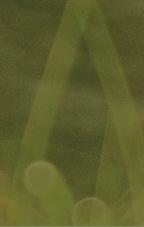
Hunters should keep in mind that once these seasonal foods are no longer available or palatable, deer will start to expand their range looking for alternatives. In areas where deer numbers are the highest, we sometimes see habitat damage or a reduction in habitat quality, resulting in deer traveling further in search of other sources of food as they prepare for winter. This is where appropriate habitat and herd management practices can assist landowners in their property goals and hunting success throughout the season. I encourage folks who are interested in learning more about habitat and quality deer herd management to sign up for the Deer Management Assistance Program — just search “DMAP” at dnr.wi.gov.

which makes up more than 90 percent of the landscape here. However, excellent deer hunting can also be found on the tens of thousands of acres of county, state and federally owned lands open to deer hunting in southern Wisconsin. Public lands often get a bad rap as being difficult to hunt but savvy hunters who are dedicated, adaptable, not afraid to go the extra mile (sometimes literally) and occasionally utilize non-traditional methods will find adventure and plenty of deer to match wits with each fall. If you’re looking for a new area to hunt and have never explored our public lands, I highly recommend giving it a shot. If you plan to hunt on private lands, get out well in advance of deer season to meet with landowners and request permission if you don’t already have it. Adapt to changing conditions and don’t be afraid to be mobile.

Despite the slow start to spring this year, early season natural food sources appear to be a little behind but doing well. These food sources will provide plenty of opportunities for hunters to observe deer taking advantage of the early season forbs as well as soft mast and other herbaceous growth. The USDA Wisconsin Crop Progress Report states crops across the state are about two weeks behind last year but are still in line with the five-year average and are of high quality. Desirable summer weather conditions can quickly close that gap. However, I don’t think

Most deer within the Southern District are harvested on private property,
Southern District deer hunters also need to keep in mind the increase in prevalence and geographic area of CWD within the district and state. Last year, Wisconsin detected just over 1,300 CWD-positive deer through hunter sampling efforts, the majority of which came from the Southern District. Washington County detected its first wild CWD-positive deer in 2020 leading to the prohibition of baiting
in Ozaukee County and thus, prohibiting baiting/feeding in all 18 counties within the Southern District.
County Deer Advisory Councils (CDAC) are offering, on average, similar quotas and antlerless deer harvest authorizations in addition to additional hunting seasons in response to public feedback and the stable to increasing deer population trend. For the 2022 deer hunting season, 13 counties in the Southern District are offering the antlerless-only Holiday Hunt and 11 counties are offering the extended archery/crossbow season. Check out our Deer Hunting homepage for more details and maps showing which counties are offering additional seasons. These additional seasons are a great way to enjoy family time afield during the holiday season and to put extra meat in the freezer.
In all, the 2022 deer season seems to be shaping up nicely and is already highly anticipated by many outdoor enthusiasts.
For a complete overview of all deer hunting rules, including changes for this season, please check the 2022 Wisconsin Hunting Regulations, which are available online, at hunting license vendors or at DNR Service Centers. For additional information, visit dnr.wi.gov and search “deer.”
Thursday, November 17, 2022 Page 11 Outdoors
Wisconsin Department of Natural Resources
PHOTO CREDIT: iStock.com / vicm
Wisconsin Department of Natural Resources
year as harvest opportunity is adjusted based on recent deer harvests and population trends, as well as on hunter experiences and feedback to County Deer Advisory Councils.
modified the number of antlerless harvest authorizations that will be issued with each license. Some metro sub-units also have modified permit availability. See the Bonus antlerless permits go on sale Aug. 15 and can be purchased at a rate of one per person
AND CROSSBOW Sept. 17–Jan. 8, 2023
EXTENDED ARCHERY AND CROSSBOW Jan. 9–31, 2023 YOUTH DEER Oct. 8–9
GUN DEER HUNT FOR HUNTERS WITH DISABILITIES* Oct. 1–9
TRADITIONAL NINE-DAY GUN DEER Nov. 19–27 METRO SUB-UNIT GUN DEER** Nov. 19 to Dec. 7 MUZZLELOADER Nov. 28–Dec. 7
FOUR-DAY ANTLERLESS HUNT Dec. 8–11
ANTLERLESS-ONLY HOLIDAY HUNT** Dec. 24–Jan. 1, 2023 *On sponsored properties only **In select DMUs only. See page 5 for details.
Wisconsin Department
Page 7
Southern District
of Natural Resources
Eric Canania, WDNR Deer Biologist
An Outdoorsman’s Journal


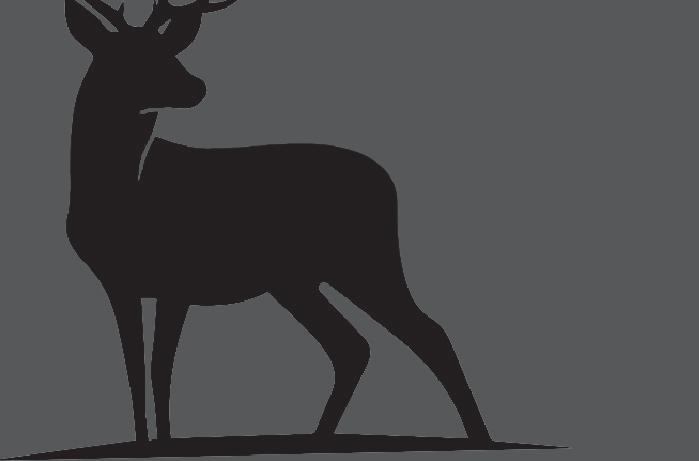 Mark Walters, Columnist
Mark Walters, Columnist
Hello friends, What you are about to read is good stuff and it is about one of the craziest, most unique and challenging days of my 61 years walking this earth. Five days earlier I had left Wisconsin on a solo, public land elk and mule deer hunt. My plan was to put much of my time and energy into scouting and building a base camp, as well as a spike camp in the Gallatin National Forest in southern Montana. This column is about the first day of my hunt, which was Montana’s opening day.

Saturday, October 22nd High 32°, Low 24°
I spent my night sleeping/listening to rain as it fell on my tent. I was at my spike camp, which was close to a mile below where I planned on hunting, and two miles above my base camp.
A major snowstorm was supposed to follow the rain and at 4:00 a.m. I said “to heck with it, I am not crawling up that mountain in the dark, in the rain.” At 4:45 a.m. my conscience got the best of me, and I dressed and began my trek, at that time the rain changed to snow. I might add that when I dressed, I pulled out a Sasquatch sweatshirt out of my pack that my girlfriend Michelle Chiaro, who passed away on June 15th, used to wear.
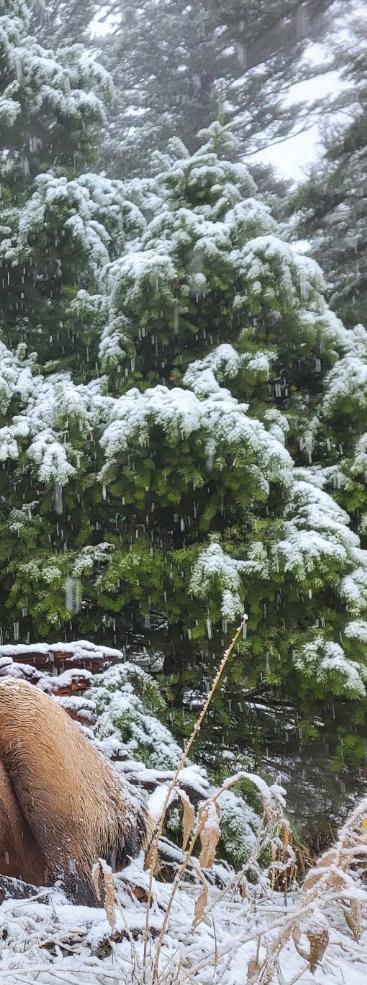
I was overdressed for the trek/ climb and got too hot. An hour before daylight I was sitting on the root ball of a deadfall with two umbrellas covering me. I would be watching a park/meadow where elk and deer like to feed that was surrounded by dark timber, spruce. I was near the top of a summit and on one side of the park it was a straight drop down the mountain.
Daylight is starting to happen and just like that I felt the presence of something, looked behind me and maybe 50 yards into the timber were three elk. With my tag I could harvest either an antlerless elk or a bull with at least a 4-inch brow tine. One looked like a small bull, but I could not tell and they wandered off.
Less than one hour later a cow elk that seemed to be as big as a horse appeared out of nowhere from the other side of the mountain. She was followed by a calf and two other cows. All four were heading towards me and about 90 yards away.
I saw the bulls’ antlers first as his body had not cleared the other side of the mountain yet and it was an amazing sight, as they were large. When his body came over the mountain he looked like a horse with very large antlers. I had to give him about a minute to clear some trees and I put a round from my 300 in the vitals. The bull ran towards me, I fired three more times and just like that my elk hunt was complete, I had just harvested a mature 6x6.
When I walked up to him, I was honestly amazed at how physically enormous he was and later found out that a mature bull elk weighs between 700-1100 pounds, this guy was all of 900.
The job of skinning and quartering was a no nonsense, get it done task. I literally straddled the carcass and worked as fast as I could because I knew I would lose daylight. My plan was to use a plastic Otter Sled and haul about 125-pounds at a time. Had a drone been following, that would have made for a great video. On at least 12 occasions I either tripped over an unseen rock or deadfall or my sled that I was pulling started going so fast it would run me over.









Twice I went down the mountain at least 30 yards with no control other than my arms and the only thing that stopped me was either trees or rocks. The art of falling is known to few.
When I returned from my second trip, I could see in the very fresh snow that three dog/wolf/who knows type of animals had found the bull and even taken a couple of bites. The trips were so physical that I did not even carry my gun, but I did have bear spray.


I became as soaked as you could be with multiple layers of clothes on. Sweat from the inside and blood and melting snow from the outside. Every step I left a trail of blood and the pain from the falls was kicking my ass. At exactly dark thirty I made it to my spike camp with my last load. Even though I had used a rope under a tarp, my tent was collapsed. I buried the meat in the snow and there was no way it was going down the mountain on this day to my base camp.

My
night.
Nothing mattered, I got my bull!
Sunset
Follow along the adventures of Mark Walters, a syndicated outdoor adventure columnist who lives in Necedah, Wisconsin. He began writing his column, An Outdoorsman’s Journal, in 1989. It includes hunting, fishing, lots of canoeing and backpacking. He currently writes for around 60 newspapers on a weekly basis. He hopes you enjoy reading about his adventures!
Want to read more?
Thursday, November 17, 2022 Page 12 Outdoors & Recreation
Photo contributed by Mark Walters
Mark Walters spike camp the morning after he harvested his bull and during a 16-inch snowfall.
weeks’ columns
Check out previous
at www.outdoorsmansjournal.com
Montana Elk Hunt/The
Bull
Photo contributed by Mark Walters The harvesting of this 6x6 bull elk was an epic experience for Mark Walters.
Photo contributed by Mark Walters The conditions on this Montana elk hunt were just as beautiful as they were brutal.
reward was peanuts, granola bars and two cans of Pabst Blue Ribbon in a tent that was pelted with snow the entire
BLAZE ORANGE BOARD PRESENTED BY SPONSORS AND PARTICIPATING BUSINESSES STILL ABLE TO JOIN MORE PRIZES BEING ADDED FIRST PRIZE BIGGEST BUCK CROSSFIRE HD 1400 RANGEFINDER FIRST PRIZE BIGGEST DOE CROSSFIRE HD 1400 RANGEFINDER WE WANT TO SEE YOUR DEER HUNTING PICTURES! We d love to see photos of the big buck or doe you bagged! We celebrate big bucks of course but we want to see everything that celebrates the rich culture of deer hunting be it a youngster’s first deer, your view out in the field or from your stand Submit photos or videos with brief description, the hunter’s name (and the names of anyone else in the picture including the age of a youth hunter) along with the location Both archery and gun entries are welcome Hunter must be from Sauk, Richland or Iowa counties or hunted in those counties Categories include: Biggest Buck, Biggest Doe, Best Youth Harvest, Best View Out in the Field Pictures must be received by Dec 9, Blaze Orange Board out Dec 15 Submissions: editor@valleysentinelnews com


















 Doug Swenson, Contributed
Doug Swenson, Contributed







 Katie Green, Columnist
Katie Green, Columnist


















































 Mark Walters, Columnist
Mark Walters, Columnist












